
Explore Our Museum's Highlights!
In what follows, we present to the general public our finest artworks and most precious treasures. Visit us and discover the most significant relics left behind by the peoples of the Carpathian Basin and the most important relics from the history of the Hungarians. We await you in the archaeological and historical exhibitions of the Hungarian National Museum!
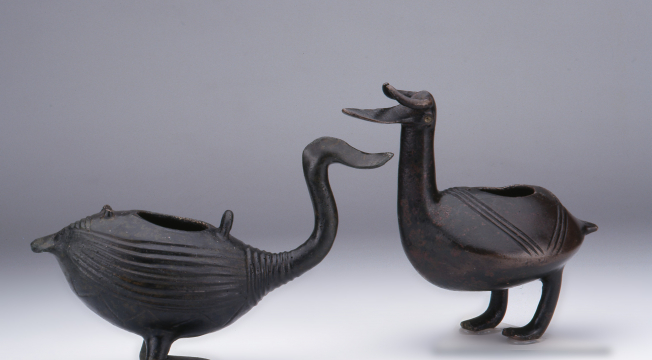 50
50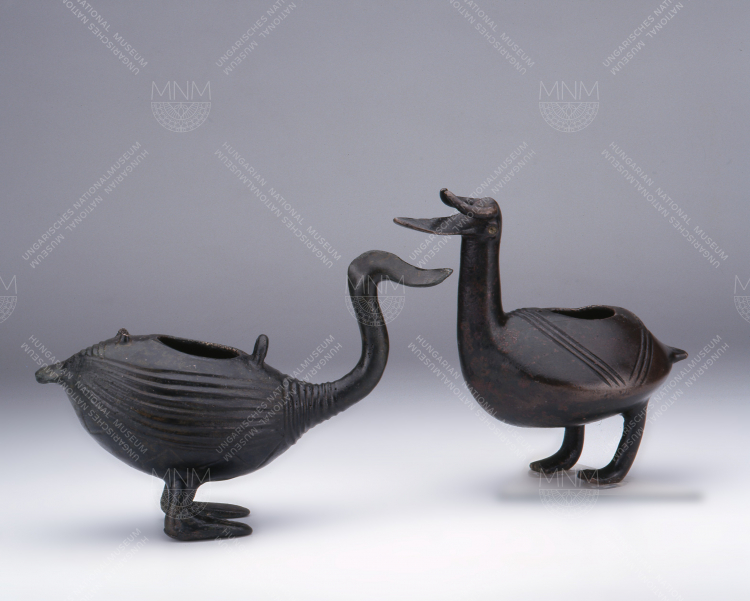
BIRD-SHAPED BRONZE VESSELS
Csicser, find-site unknown
10th century BCE
(Between East and West, Room 3)
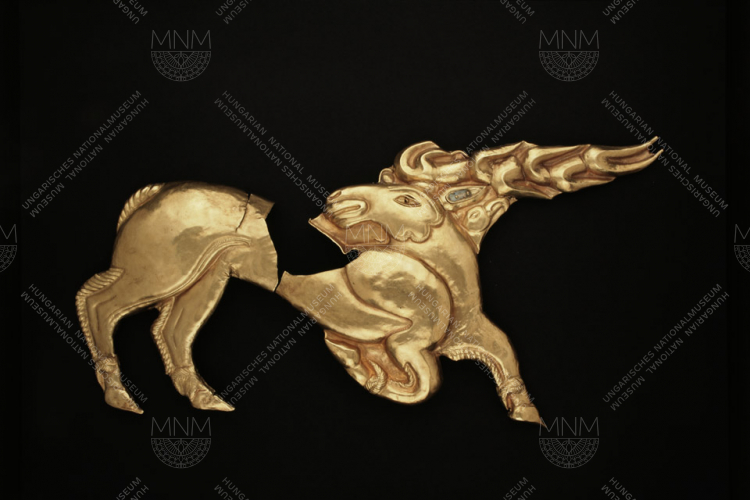
SCYTHIAN GOLDEN STAG, FROM ZÖLDHALOMPUSZTA
At Zöldhalompuszta, near Mezőkeresztes, grave goods consisting of a golden stag, a gold chain ornamented with lion figures, 138 semi-spherical gold forms, and a gold pendant were discovered in 1928. The 38-cm-long stag figure, dropping down on its front legs and with its head turned backwards, is made from sheet gold and has ormanentation in relief. The animals’s head and legs are decorated with a cord pattern. On the area between the antlers and the neck can be seen the head of a bird with a hooked beak. Artefacts similar to the stag figure have come to light among finds from the kurgans of Scythian ruling princes on the steppes of Eurasia. It was made as an ornament for a shield, and it symbolised the social position and power of the shield’s user. The magnificent assemblage may have been committed to the earth during the 6th century BCE
(Between East and West, Room 5)

Seuso Treasure
Probably Kőszárhegy
4th - beginning of the 5th century CE
The Seuso treasure is a treasure trove from the late period of the Roman Empire (4th – 5th centuries). It was named after its owner Seuso, who is identified on the inscription of the so-called hunting or Seuso platter. Its pieces belong to a festive banqueting set and include vessels used for washing and during toilette. Probably in the last decades of the 4th, or at the beginning of the 5th century, the treasure was concealed by its owners, who were most likely fleeing from a war conflict.
In its currently known form, the hoard consists of 14 large silver vessels, as well as a large copper cauldron, in which the items were hidden. Among some thirty precious metal treasure troves including pieces of banqueting sets from the late imperial period, the Seuso treasure is outstanding with regard to both its artistic and material value. Bearing in mind its total weight, the silver set displayed at the exhibition is considered as the most valuable among the existing late imperial silversmith treasures.

ONYX FIBULA
Gold, onion-shaped fibula with an onyx gemstone
Szilágysomlyó,
First half of the 5th century CE
(Between East and West, Room 7)

SILVER FIBULA COVERED WITH SHEET GOLD, WITH GARNETS
Szilágysomlyó,
First half of the 5th century CE
(Between East and West, Room 7)

FOOTED GOBLET MADE OF GOLD
Bócsa, first half of the 7th century CE
Similar to this golden goblet with scalloped decoration, drinking vessels splaying at the rim that were made from sheet silver (unlike this piece from Bócsa) and large, handled jugs that matched them in shape were, it seems, indispensable elements in the sets of drinking vessels used by Avar dignitaries in the 7th century CE. Made locally in the Carpathian Basin and distinct with regard to design, these pieces indicate the developed nature of Avar handicrafts work.
(Between East and West, Room 7)
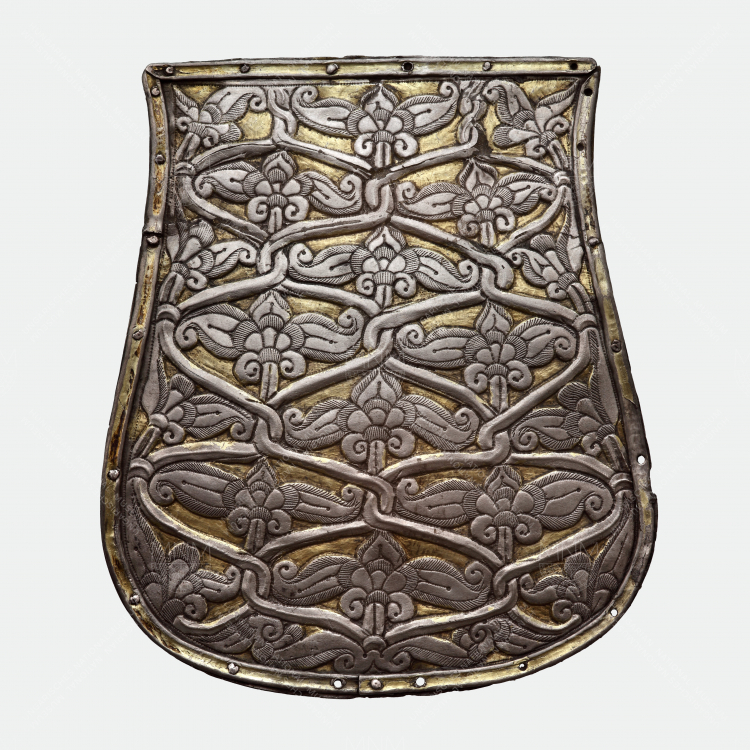
SABRETACHE PLATE
Silver gilt,
10th century
The palmette motifs in a endless knot on this sabretache plate from Galgóc are reminiscent of motifs on Oriental textiles and frescoes in the Sogdia towns. The Hungarians may have become acquainted with such designs during their time in the East. According to the protocols, horse bones, a neck torque, a pair of earrings, and a silver Arab dirhem were found along with the sabretache plate in the male burial, which was discovered in 1868. The coin, which had been drilled through, was struck by the Samanid amir Nasr II (r. 914–943); it was issued in Samarkand in 918–919. Its last owner may have had it sewn into his clothing or his horse’s harness at the end of the first third of the 10th century.
(Between East and West, Room 10)
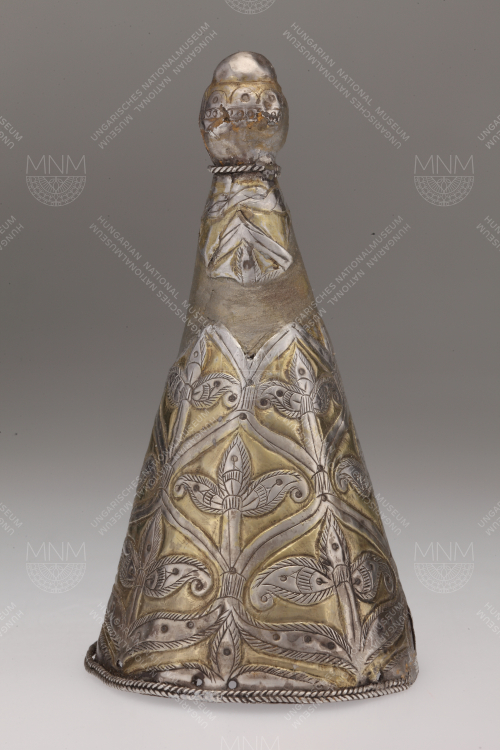
METAL TIP FOR A POINTED CAP, FROM BEREGSZÁSZ
Embellishment decorated with palmettes, from Beregszáz
(Beregovo, Ukraine)
(Between East and West, Room 10)
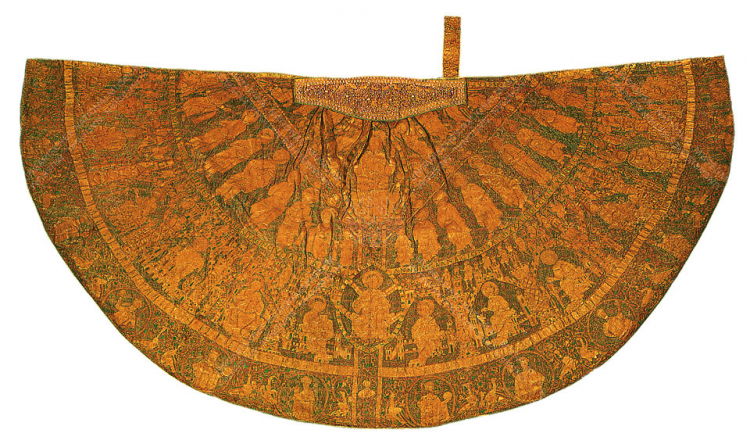
CORONATION MANTLE
This priceless treasure of European textile art was orginally a chasuble. According to the inscription written on it in hexameters, this chasuble was ordered by King Stephen I and Gisela his queen consort in 1031. The masterly gold embroidery which covers almost the entire surface of the piece was made according to a complex pictorial scheme whose basis may have been, according to some researchers, the Te Deum or All Saints litany. Its significance is further heightened by its use, right up until the 20th century, as the mantle worn by kings of Hungary at their coronation.

BYZANTINE VESSEL FOR HOLY WATER, FROM BESZTEREC
Second half of the 10th century
This Byzantine silver-gilt holy water vessel inscribed in Greek rests on three – in part reconstructed – lion-griffin feet. On a hexagonal base, the broader lower part of its body is connected to the narrower upper part by a stepped element. On the top, there is a handle, which moves. This is connected to the vessel by means of busts of two youths, and, at the level of the chests of the youths, a damaged inscription in Greek can be seen. The present teading of this is ‘Christ, the living fount of healing’. The vessel is covered by trailer with palmettes on a ground decorated with circles consisting of punched dots. In a lower, oval-shaped space, three palmettes alternate with three mythological beasts. The palmettes are early relics of the so-called flower-and-leaf decoration renewed at the imperial court at Byzantium in the mid-10th century on the basis of Chinese examples.
(History of Hungary, Part One, Room 1)
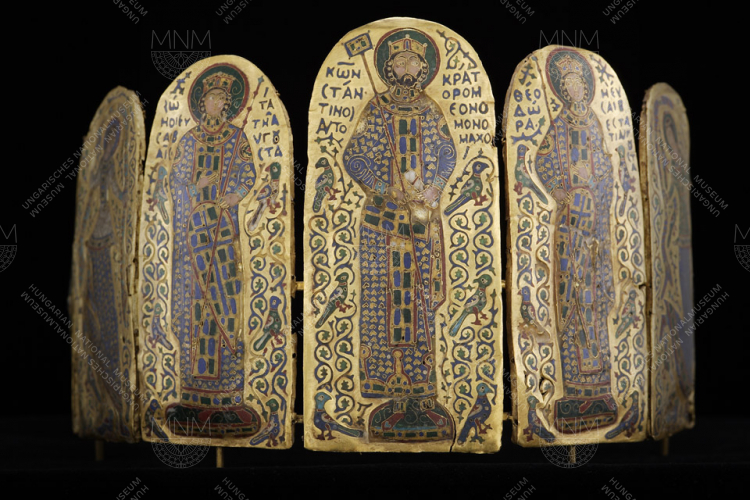
MONOMACHOS CROWN
Crown of Constantine IX Monomachos, Byzantium, 1042–1050
The assemblage consists of seven gold plates each of which has a semi-circular top and cloisonné enamel decoration. It was recovered at Nyitraivánka (Ivanka pri Nitre, Slovakia) in 1861. The plates depict, respectively, Constantine IX Monomachos, emperor of the ‘Romans’, (r. 1042–1055), and six standing female figures; there are also two medallions featuring busts of the apostles and brothers St. Peter and St. Andrew respectively. The assemblage contains three pairs of gold plates, each of a different height. Two of the gold plates show the last members of the Macedonian dynasty: Zoe (d. 1050) and her sister Theodora (d. 1056) respectively. Two others each depict a dancer, and another two Justice and Humility respectively. The figures are flanked by decoration consisting of trailer and birds and (in the case of the Virtues) pairs of cypresses. The plates may originally have been attached to a cap and may be interpreted as a universal peace programme in a Sassanid, Islamic, antique, and Old Testament context alike. For their part, the two apostles, included in the assemblage in a secondary role, refer to Rome and Constantinople, locations associated with their respective activity, as well as to the Latin and Greek churches they respectively led.
(History of Hungary, Part One, Room 1)
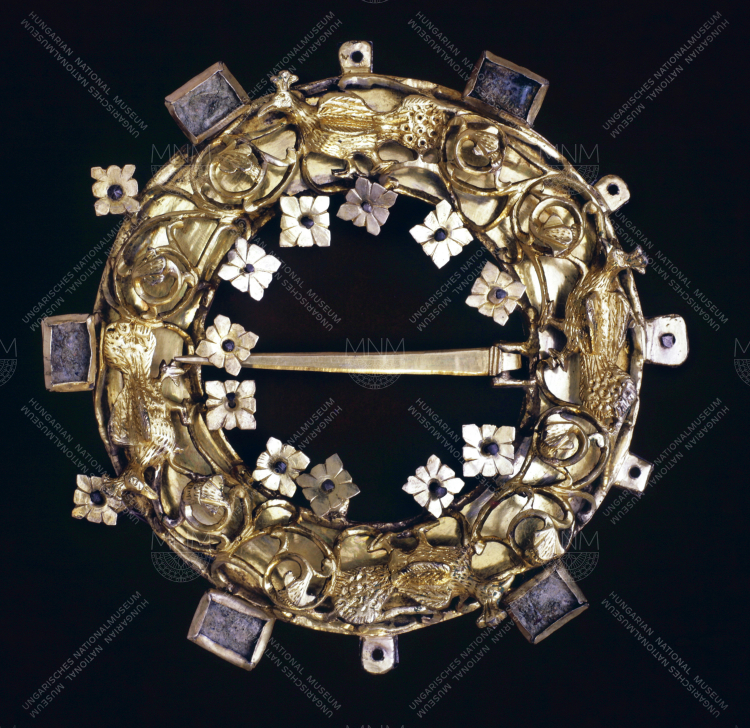
MANTLE CLASP
This silver-gilt clasp, recovered at Bajna, was made in the mid-13th century using the opus duplex technique especially favoured at the courts of Andrew II and Béla IV.
(History of Hungary, Part One, Room 1)

CROWN FROM MARGARET ISLAND
Silver-gilt crown with gemstones
Margaret Island, Budapest, 13th century
Decorated with lilies and rosettes, this crown was recovered in 1838 from one of the royal burials (perhaps that of King Stephen V of Hungary) at the Dominican nunnery on Margaret Island. Influenced by the classic French Gothic style, it may been made in the second half of the 13th century.
(History of Hungary, Part One, Room 1)
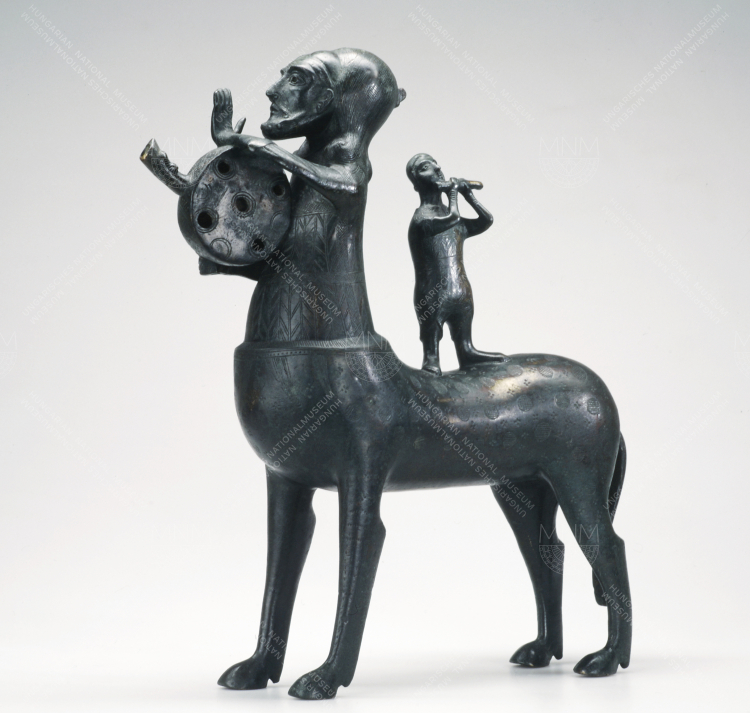
AQUAMANILE
cca. 1200
The centaur and the boy figure playing a flute and standing on its back (perhaps Chiron and Achilles) is a product from the 1220s made by an outstanding bronze-casting workshop in Hildesheim. It may have reached Hungary on account of the close links between the court of Hungary’s King Andrew II and the Holy Roman Empire.
(History of Hungary, Part One, Room 1)

TRENCSEN HELM
Late 14th century/early 15th century
(History of Hungary, Part One, Room 2)
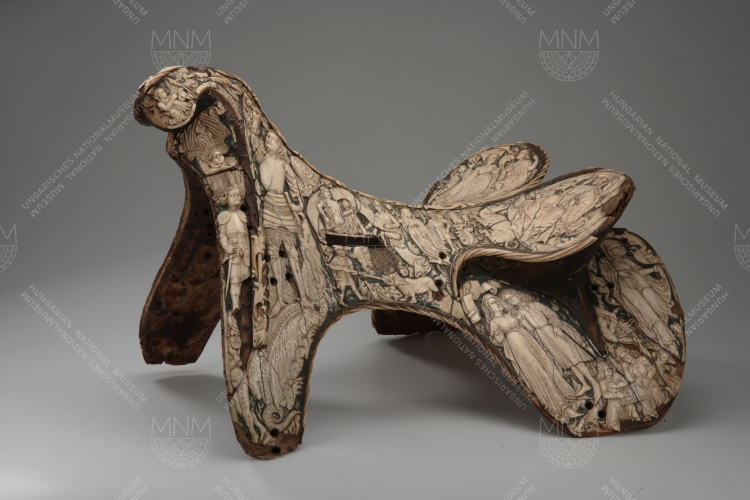
CEREMONIAL SADDLE
Ceremonial saddle from the time of Sigismund of Luxemburg, cca. 1408–1425
Many bone carvings on this ceremonial saddle, which was purchased by Miklós Jankovich in Bucharest, feature themes connected with St. George and the Dragon. These themes were favoured at court. However, we also see the emblem of the Order of the Dragon, which was founded by King Sigismund. This underpins the legend that the saddle originally belonged to Vlad III (Vlad the Impaler), prince of Wallachia, a ruler also known as Vlad III Dracula, on account of his membership of the order.
(History of Hungary, Part One, Room 3)

LITURGICAL CRUETS FROM NAGYVÁRAD
First quarter of the 16th century
From Nagyvárad, this pair of jugs for liturgical use from the early 1500s combines Late Gothic naturalism with filigree decoration. Purchased from the Bethlen family and made in the first quarter of the 16th century, the jugs, which are from Nagyvárad Cathedral according to Bethlen family tradition, feature the Nuremberg Late Gothic pear shape along with more abstract granulated filigree surface decoration, which is considered a Hungarian speciality. One of the earliest known drawings of a pear-shaped product of goldsmiths’ art is by Albrecht Dürer, whose father was from Ajtós, near Nagyvárad. In this way, the artefact attests to Hungarian links with Nuremberg in the field of goldsmith’s work in the time of Dürer also.
(History of Hungary, Part One, Room 4)
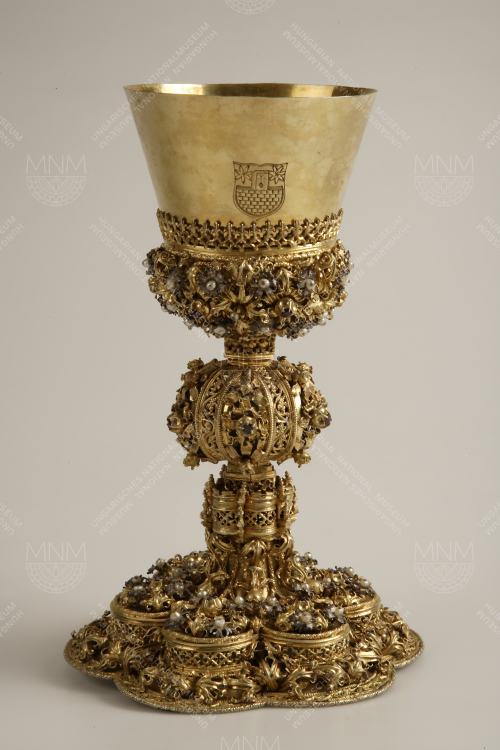
GOBLET
Goblet with the armorial bearings of the Ernuszt, the Pálóczi and the Rozgonyi families. Decorated with burring and beading and fashioned in the late 15th century, this goblet may have been commissioned by János Ernuszt, chief equerry to King Vladislaus I of Hungary; on it are Ernuszt’s armorial bearings, and also those of his father-in-law and mother-in-law.
(History of Hungary, Part One, Room 4)
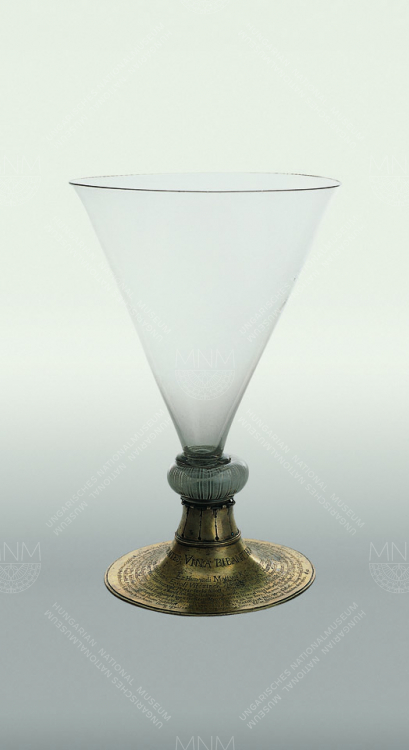
GLASS STOOP ONCE BELONGING TO KING MATTHIAS CORVINUS
Glass stoop once owned by King Matthias Corvinus of Hungary, Venice,
second half of the 15th century; foot: late 16th century/early 17th century
(History of Hungary, Part One, Room 5)
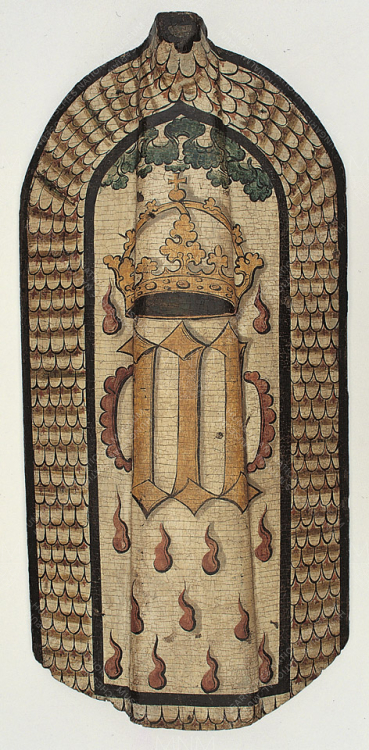
PAINTED WOODEN SHIELD
Painted wooden shield, with a letter M, referring to King Matthias Corvinus, second half of the 15th century
(History of Hungary, Part One, Room 5)
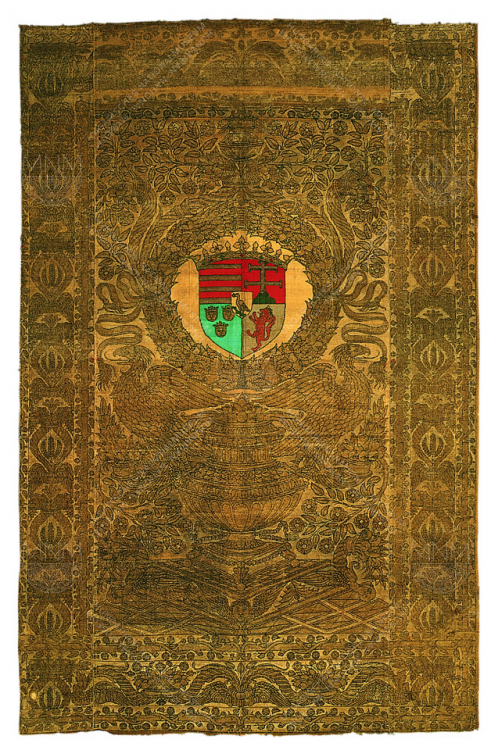
THRONE TAPESTRY
Most 15th-century textiles that have come down to us are pieces which were ecclestiastical commissions and which were in ecclesiatical use first and foremost. However, this tapestry, commissioned by King Matthias Corvinus and considered a masterpiece of Italian textile art, was made specifically for secular use. Set in a wreath of fruit, the armorial bearings indicate the person who ordered the tapestry, while the detailed artistic design and the costly materials employed serve display purposes.
(History of Hungary, Part One, Room 5)
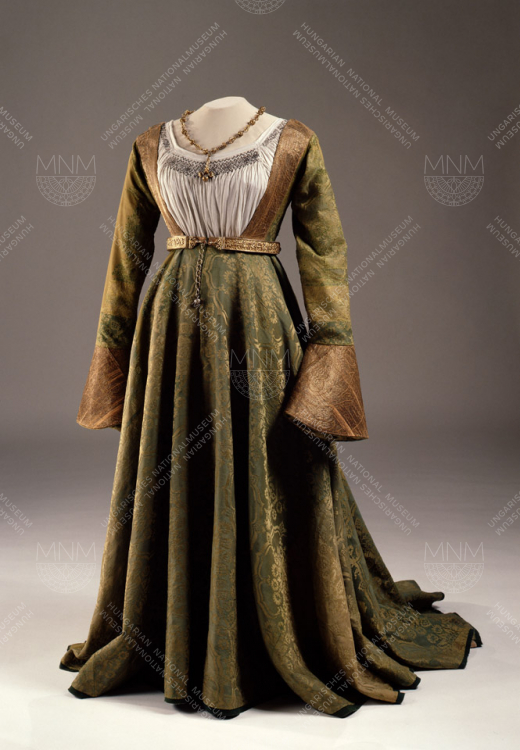
ATTIRE ASSOCIATED WITH MARY OF AUSTRIA, QUEEN CONSORT OF HUNGARY
The earliest women’s attire held by the Museum’s Textile Collection, this clothing may have belonged to the wardrobe of the spouse of King Louis II of Hungary. The ground fabric is green Italian damask; there are cone-shaped cuffs with metal thread and strips which embellish the upper part. The attire consists of two garments: a long chemise and the green outer garment following the Burgundian fashion.
(History of Hungary, Part One, Room 5)
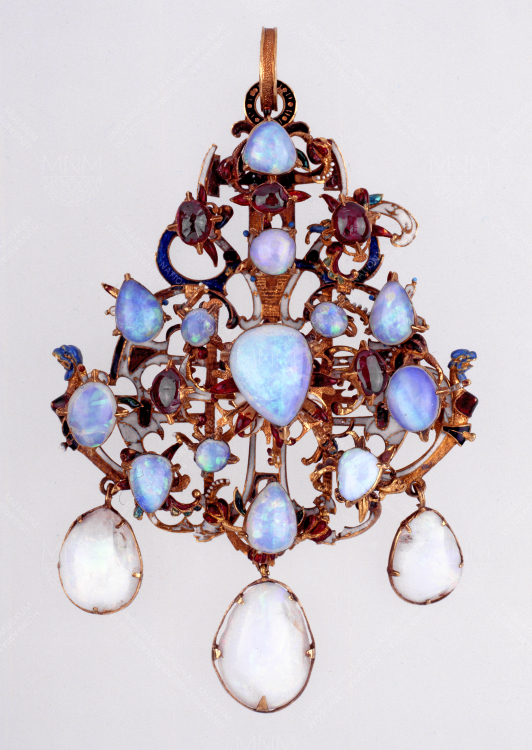
PENDANT
Pendant decorated with an opal, first half of the 16th century
Set with an opal and made with sophisticated artistic taste, the artefact testifies to the high technical standard of jewellery art at this time. Tradition has it that this pendant belonged to Isabella, queen consort of King John I (Szapolyai) and later queen dowager.
(History of Hungary, Part One, Room 6)

SET OF CHOIR STALLS FROM NYÍRBÁTOR
The Renaissance magnificence of the court of King Matthias Corvinus of Hungary and Beatrix his consort was accompanied by the rapid spread of the Renaissance style in the country. An outstanding example of it is this set of choir stalls commissioned by the Báthoris: the ledges, friezes, supports, back panels, arm supports, seat surrounds,, side panels, dividing panels between the individual seats, and arched recesses are all made in the Renaissance style, with carving and inlay work. One panel shows the names and ranks of those placing the order (György, István, and András Báthori), as well as the year of production (1511); on another panel we can see the mark of the master who made the stalls: F. Marone. Some of the inlaid back panels depict cupboards with half-open doors, revealing books and vessels on the shelves inside.
(History of Hungary, Part One, Room 6)
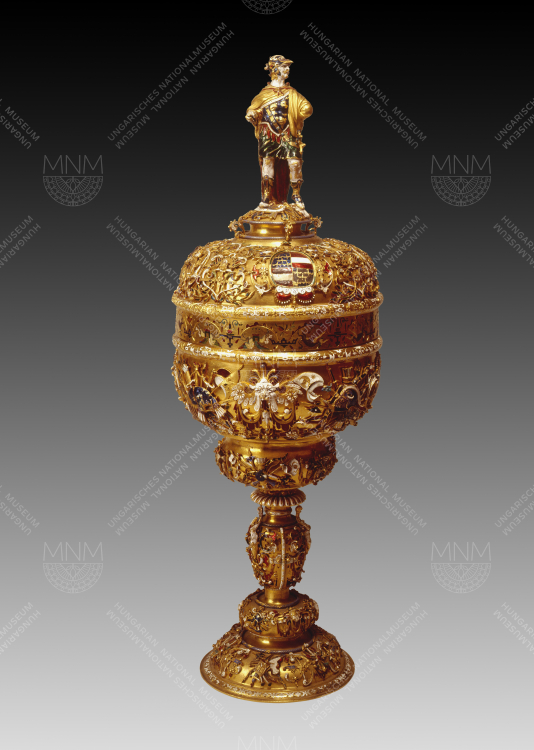
PÁLFFY STOOP
Gala stoop that one belonged to Count Miklós Pálffy, 1598
(History of Hungary, Part One, Room 6)

BRÓZER CHALICE
Golden chalice
Donated to the Reformed Church in Kolozsvár by György I Rákóczi
István Brózer,
Kolozsvár, 1640
(History of Hungary, Part One, Room 7)
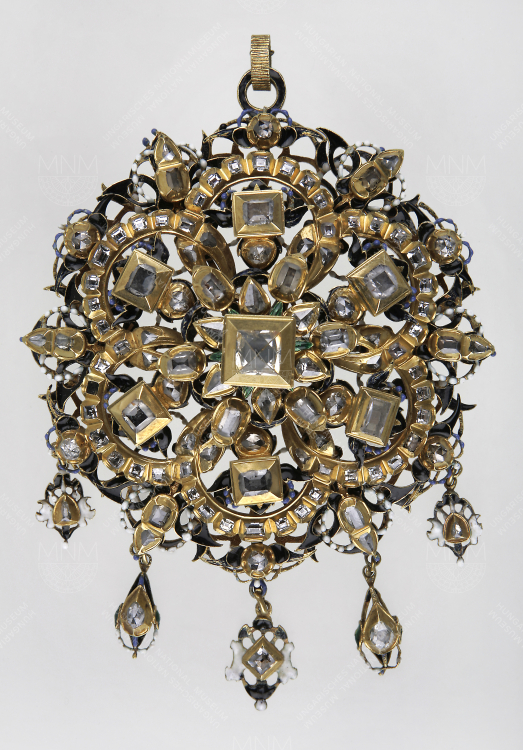
DIAMOND PENDANT
cca. 1620–1640
(History of Hungary, Part One, Room 7)

GALA ATTIRE ONCE BELONGING TO CATHERINE OF BRANDENBURG
Tradition has it that this plum-coloured silk attire was worn by Catherine of Brandenburg, the second wife of Gabriel Bethen, prince of Transylvania. The clothing, which consists of a skirt and a bodice, is richly embroidered with metal thread. The tulips, carnations, and daisies seen below the arching are elements frequently found on surviving 17th-century embroidery in the Hungarian territories.
(History of Hungary, Part One, Room 7)

EMBLEM OF THE ORDER OF ST. STEPHEN
Gemstone-decorated emblem of the Royal Hungarian Order of St. Stephen worn by Maria Theresa, 1764
(History of Hungary, Part Two, Room 10)
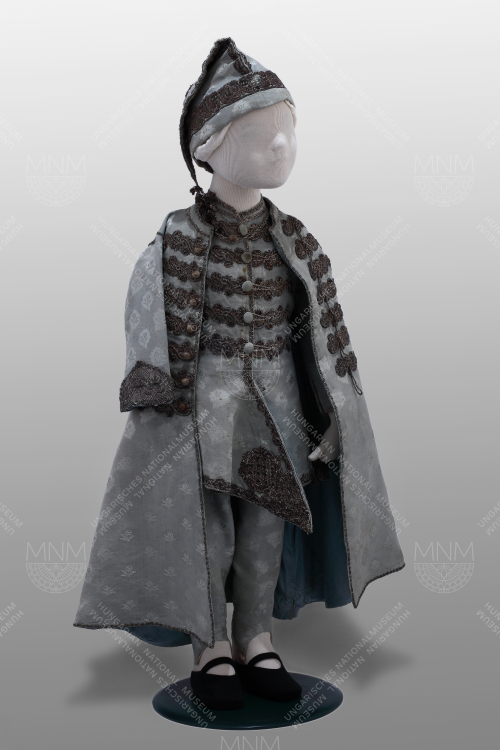
GALA ATTIRE FOR A MALE CHILD
According to tradition, this Hungarian-tailored set of clothes consisting of a mente (a long Hungarian coat), a dolman, trousers, and cap was made for Joseph, the eldest son of Maria Theresa. It is cut from floral-patterned silk repp. We know of many pictures showing the monarch and her children in Hungarian attire.
(History of Hungary, Part Two, Room 10)
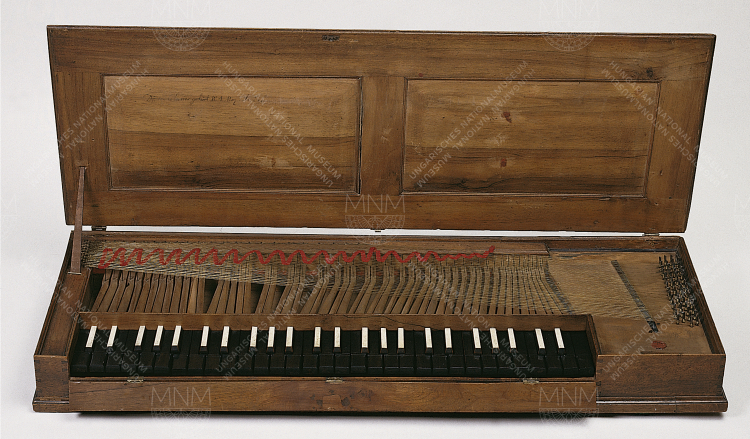
MOZART’S TRAVELLING CLAVICORD
This small, simple, travelling instrument made by Johann Andreas Stein in 1762 is more than merely the sole surviving clavicord made by the famous Augsburg organ builder (the inventor of the so-called Vienna action. It is also a travelling and practice instrument that was used by Wolfgang Amadeus Mozart. The instrument and the documentation connected with it were purchased by the Museum in 1965.
(History of Hungary, Part Two, Room 13)

COUNT ISTVÁN SZÉCHENYI
Painting by Miklós Barabás, 1848
At the Hungarian Diet of 1825, Count István Széchenyi, the initiator of the Reform Age in Hungary, offered a year’s income from his estates for the foundation and endowment of a Hungarian Academy of Sciences, ‘to strengthen and develop nationhood and the language’. His many impressive achievements aimed at the creation of a modern Hungary. Széchenyi was a fine-looking man who spoke foreign languages; who read works of classical and modern literature in the original; who was a great sportsman who excelled at swimming, riding, and rowing; and who was, in addition, a member of aristocratic society. Initially, he considered the Austrian Empire as a whole to be his homeland, but later, in the 1820s, decided that he wished to live his life as a public person fighting for the benefit of the Hungarian nation and for the advancement of Hungary. He founded a club to promote discussion of political, economic, and social issues. In his works (Credit, World/Light, Stádium), he outlined the first comprehensive programme in Hungary for advancement from feudal poverty through the establishment of modern societal relations. Crowning his many reforming initiatives was the construction of the Chain Bridge, an all-the-year-round bridge linking the cities of Pest and Buda. By pushing through the building of this bridge, he aimed to stimulate economic activity and transportation, thus facilitaing the development of a major city, a true capital from Hungary, from these two small medieval towns on either side of the Danube; and, by doing so, to create a rival for Vienna and to attract the Habsburg Empire’s epicentre to the banks of the Danube in Hungary.
(History of Hungary, Part Two, Room 11)
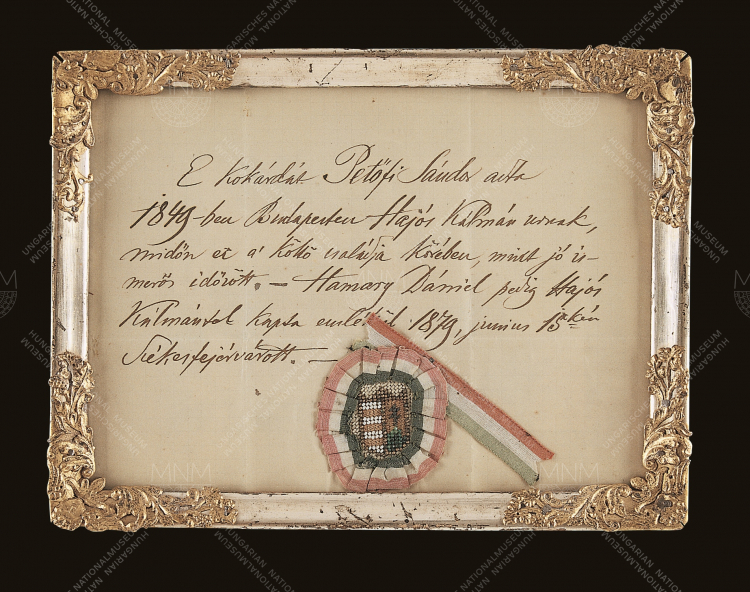
COCKADE ONCE BELONGING TO SÁNDOR PETŐFI
Sándor Petőfi is one of the most significant and influential figures in Hungarian literature. As one of the leaders of the Youths of March who sparked the 15 March 1848 Revolution and later on as a martyr of the 1848–49 War of Independence, Petőfi has become a central figure in the legendry of the nation. His life has become the subject of a cult at least as much as his poetry has. Featuring the national colours, the cockade seen here was, according to the document of attestation, in Sándor Petőfi’s possession.
(History of Hungary, Part Two, Room 12)
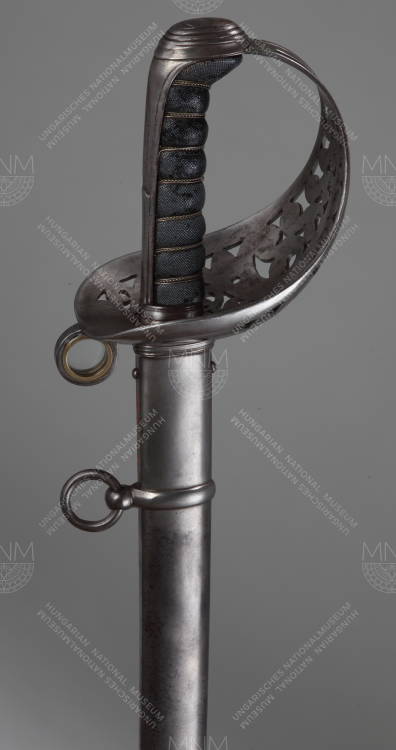
ARTÚR GÖRGEI’S SWORD
Arthur Görgei's „1845 M” cavalry officer’s sword with an embedded magnifying glass with which the notoriously short-sighted general could read maps.
(History of Hungary, Part Two, Room 12)

WAISTCOAT ONCE BELONGING TO COUNT LAJOS BATTHYÁNY
Pierced through by bullets, this white piqué waistcoat was worn by Count Lajos Batthyány at the time of his execution. Following the defeat of the 1848–49 Hungarian War of Independence, Batthyány, prime minister in the first responsible Hungarian government, was put to death on orders from Haynau, the Austrian military commander invested with full powers in Hungary. The execution took place on 6 October 1849 in the courtyard of the so-called New Building in Pest. On her last visit to him in his condemned cell, Batthyány’s loyal wife, Countess Antónia Zichy, smuggled in a small dagger. On the night before he was due to be executed, he attempted, unsuccessfully, to commit suicide with it, to avoid the shame of hanging. Because of the life-threatening wound on his neck, Batthyány was executed by firing squad. The waistcoat he was wearing at the time was presented to the Hungarian National Museum by his widow.
(History of Hungary, Part Two, Room 14)
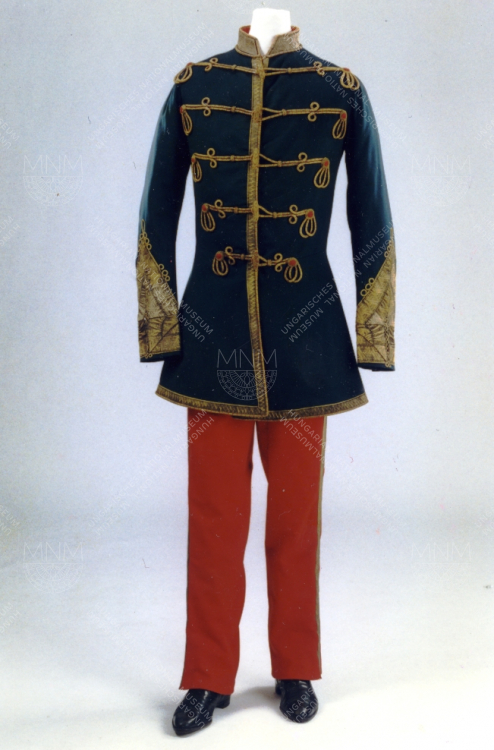
GOVERNOR-PRESIDENT’S GALA ATTIRE ONCE BELONGING TO LAJOS KOSSUTH
Consisting of a braided broadcloth atilla (Hungarian short outer coat) and red slim-fit trousers, this attire was at one time worn by Lajos Kossuth. The garments came to the Hungarian National Museum from the widow of Ferenc Kossuth, son of Lajos Kossuth.
(History of Hungary, Part Two, Room 12)
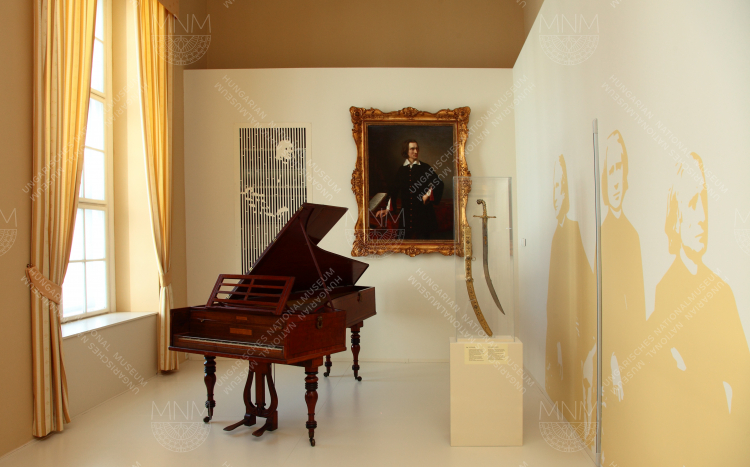
BEETHOVEN–LISZT GRAND PIANO
Grand piano once owned by Ludwig van Beethoven and later on by Ferenc (Franz) Liszt.
In 1873, after jubilee celebrations to mark the fiftieth anniversary of the start of his career, Ferenc Liszt decided, as a Hungarian patriot, to present his most precious artefacts to the Hungarian National Museum. From every point of view, the best-known work of art belonging to Liszt was a musical instrument which he acquired in 1846 and which, from that time onwards, he, too, treated as a treasure from the past. This was a grand piano made by Thomas Broadwood that was sent to Beethoven in Vienna in 1817.
(History of Hungary, Part Two, Room 13)
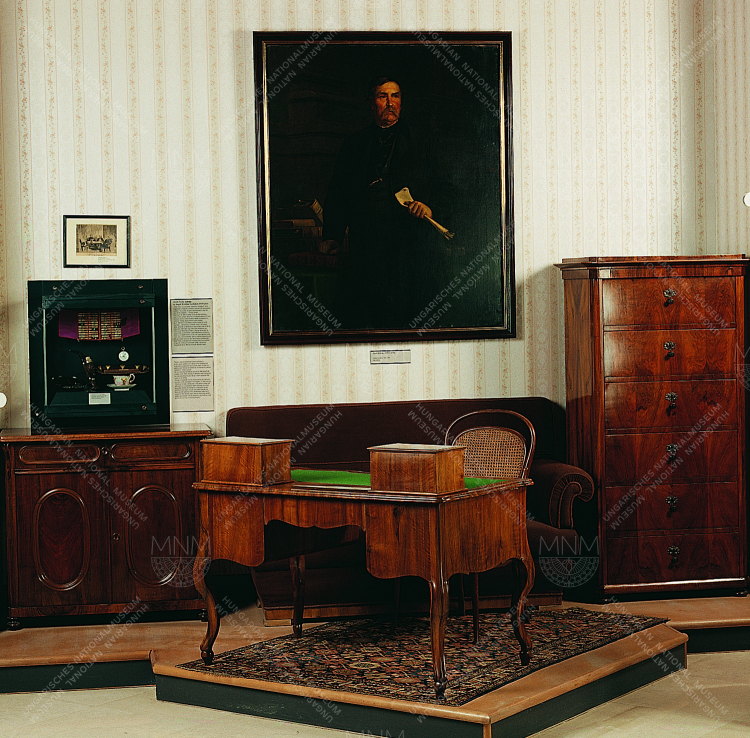
FURNISHINGS OF A ROOM USED BY FERENC DEÁK
On show here are furnishings from Ferenc Deák’s room at the Queen of England Hotel in Pest, along with some of the politician’s personal effects. Deák was one of the architects of the Compromise of 1867, an agreement between Austria and Hungary which created the Dual Monarchy (Austria–Hungary). This understanding came about on the basis of proposals formulated in Deák’s ‘Easter Article’ published without attribution in the 16 April 1865 number of the newspaper Pesti Napló. On 20 February 1867, Francis Joseph appointed Count Gyula Andrássy as first prime minister of the the Hungarian half of the Dual Monarchy, which lasted until late 1918. On 8 June 1867, Francis Joseph was crowned king of Hungary.
(History of Hungary, Part Two, Room 14)
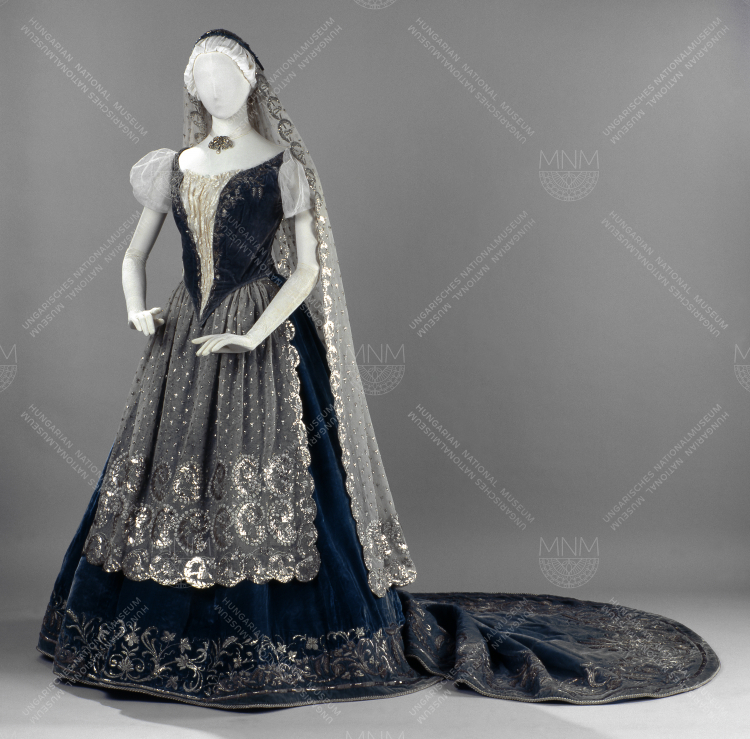
LADY’S GALA ATTIRE
Following Hungarian traditions, this blue silk gala attire was made in 1867 for the coronation of Francis Joseph I. The long train of the skirt, which accorded with court prescriptions, is covered with rich metal-thread embroidery depicting ears of wheat and vine leaves. The apron for the skirt and the veil attached to the bonnet are also embroidered in metal thread. After minor alterations, this attire was worn by Gabriella Szécsenyi at the coronation of King Charles IV of Hungary in 1916.
(History of Hungary, Part Two, Room 14)
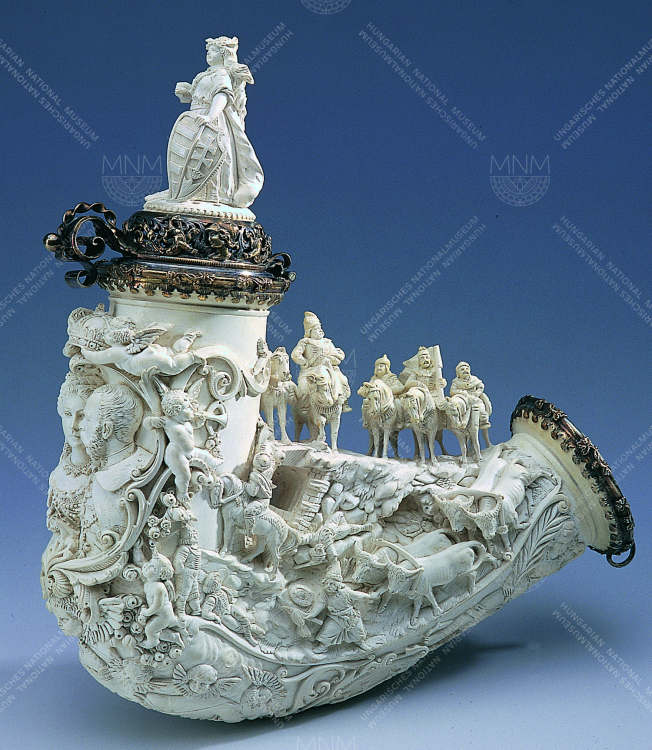
MEERSCHAUM PIPE MADE AT THE TIME OF HUNGARY’S MILLENNIUM
Adler workshop, 1896
This large pipe, made in the renowned workshop of Fülöp Adler and Son, sums up the way Hungary’s history was seen at the time of Hungary’s Millennial Celebrations in 1896, one thousand years after the arrival of the Hungarians in the Carpathian Basin. Carved from meerschaum, the bowl of the pipe consists of the allegorical female figure Hungaria; she holds the coat of arms of Hungary with its double cross and Árpád stripes. On the long neck part can be seen, on horseback, the conquering tribal chiefs and the proud figure of Árpád, the ruling prince. On either side of the shank we see the Hungarian people arriving in their new homeland (a farmer leading oxen, people on horseback); these scenes were inspired by the Feszty cyclorama. On the foot part is a half-length portrait of of St. Stephen, the founder of the Hungarian state. On the front side, in pride of place, there is a portrait of King Francis Joseph of Hungary and his consort Queen Elizabeth. Above their heads, two cherubs hold the Holy Crown of Hungary. Like this pipe, the rhetoric of the millennial celebrations extolled Francis Joseph as a second Árpád who, with ‘St. Stephen’s Crown’ upon his head, was launching the Hungarians into the second thousand-year period in their history.
(History of Hungary, Part Two, Room 14)
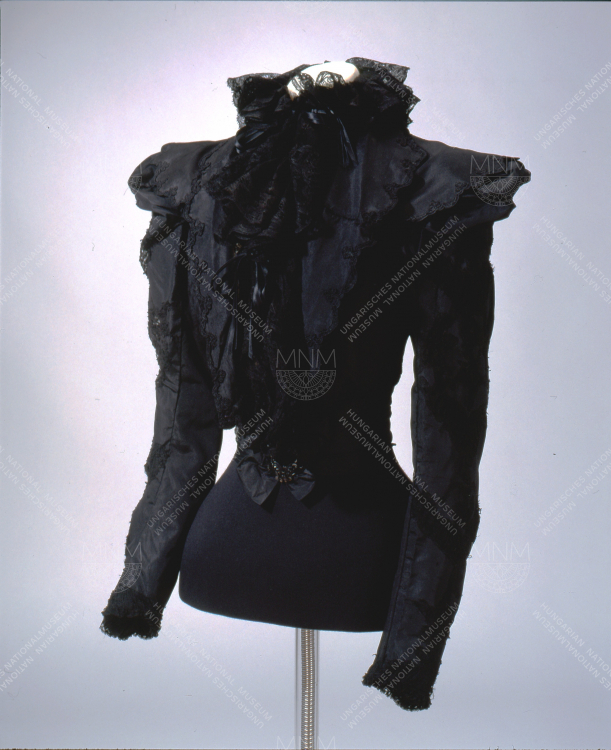
BODICE ONCE BELONGING TO QUEEN ELIZABETH (SISI)
On 10 September 1898, Francis Joseph’s consort Queen Elizabeth, so dear to Hungarians, was about to take a boat trip on Lake Geneva when she was atttacked by an Italian anarchist named Luigi Lucheni. After a minor fright, she boarded the vessel with her Hungarian lady-in-waiting Countess Irma Sztáray. She then soon became unwell, on account of of a stab wound near to her heart, and could not be saved. The black silk bodice she was wearing on the day of the attack was presented to the Queen Elizabeth Memorial Museum founded in 1907; from there it passed to the Hungarian National Museum.
(History of Hungary, Part Two, Room 15)
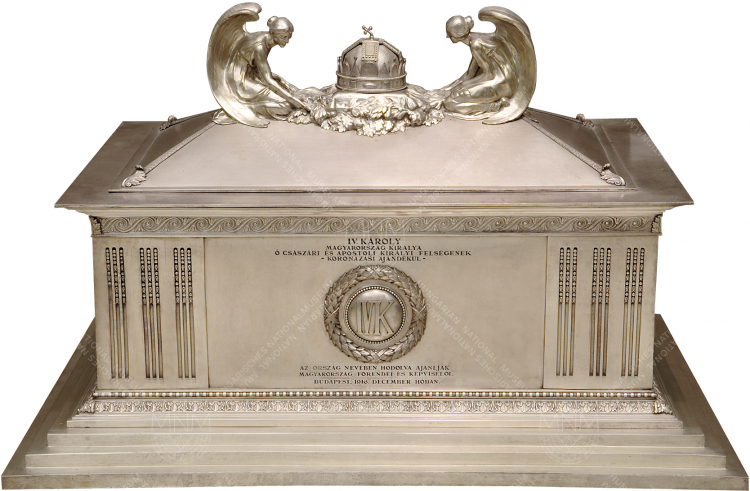
CHEST PRESENTED TO KING CHARLES IV OF HUNGARY ON HIS CORONATION
Francis Joseph, the monarch of Austria–Hungary, died towards the end of 1916, in the middle of the First World War. His successor, who reigned as Charles IV of Hungary, was crowned king of Hungary in the Matthias Church in Buda’s Castle District on 30 December 1916, amid ceremonial reminiscent of the earlier ‘happy times of peace’. In this silver chest, the country gave its present to the new monarch, along with its good wishes.
(History of Hungary, Part Two, Room 16)
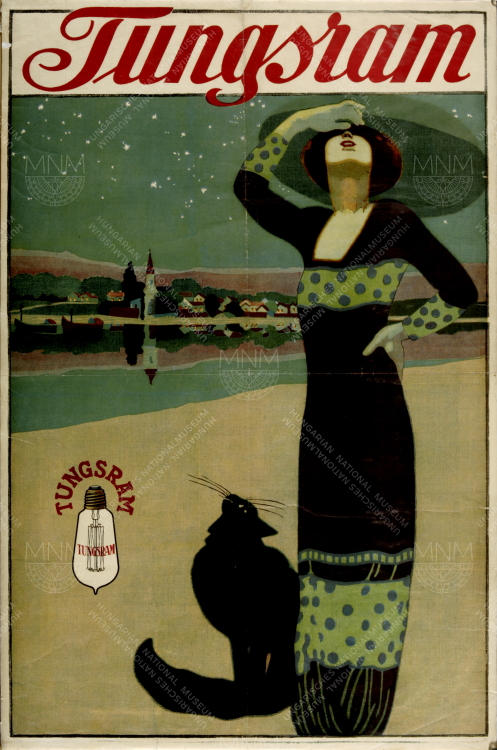
ADVERTISEMENT POSTER
Géza Faragó
Advertisement for incandescent lightbulbs that were made by the Tungsram Factory
cca. 1912
(History of Hungary, Part Two, Room 16)

FIRST WORLD WAR POSTER
Poster by Mihály Bíró against the the horrors of war; the artist made it during the Balkan Wars, cca.1912
(History of Hungary, Part Two, Room 16)

RED LOCOMOTIVE
Sándor Bortnyik: Red Locomotive,
1918 (oil, canvas)
A dynamic, Expressionist-Cubist symbol of the approaching revolutions
(History of Hungary, Part Two, Room 16)
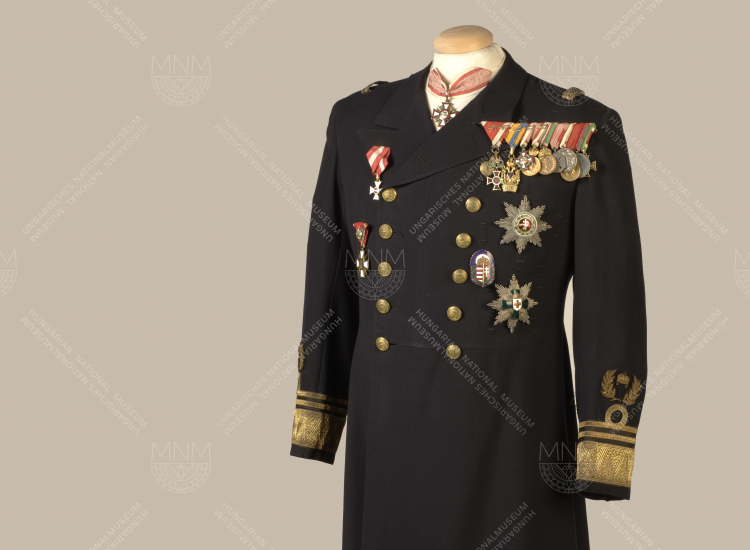
DRESS UNIFORM ONCE BELONGING TO MIKLÓS HORTHY
Admiral’s dress uniform worn by Regent Miklós Horthy
(History of Hungary, Part Two, Room 17)

ART DECO ROOM
Counterpoint to the Neo-Baroque world: corner for reading in a modern apartment in the capital city
(History of Hungary, Part Two, Room 17)

HAND TAKEN FROM A STATUE OF STALIN
Pulled down on the evening of 23 October during the Hungarian Revolution of 1956, the Stalin statue in Budapest’s City Park was one of the main symbols of the system overthrown at that time. After being toppled, the statue was broken up by the angry crowd. Our exhibition displays the ‘almighty’ hand. (The statue was made by Sándor Mikus.)
(History of Hungary, Part Two, Room 20)
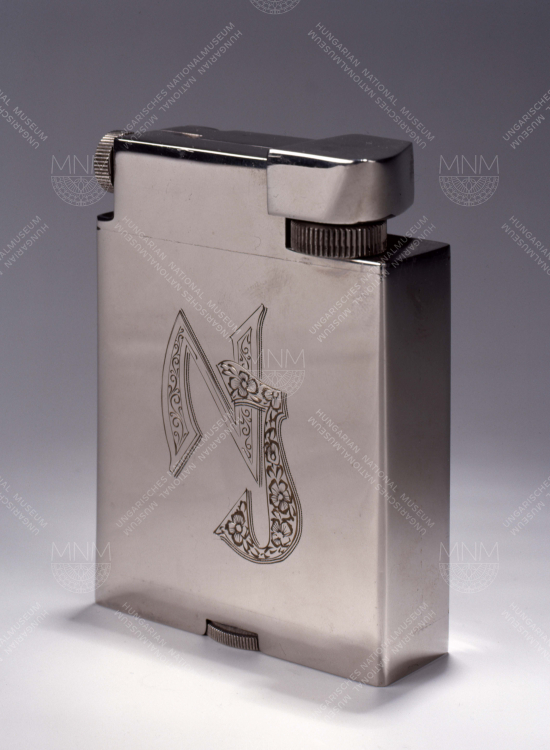
LIGHTER ONCE BELONGING TO IMRE NAGY
Table lighter with the initials of the martyr Imre Nagy, prime minister of Hungary during the Revolution of 1956,
1950s
(History of Hungary, Part Two, Room 20)
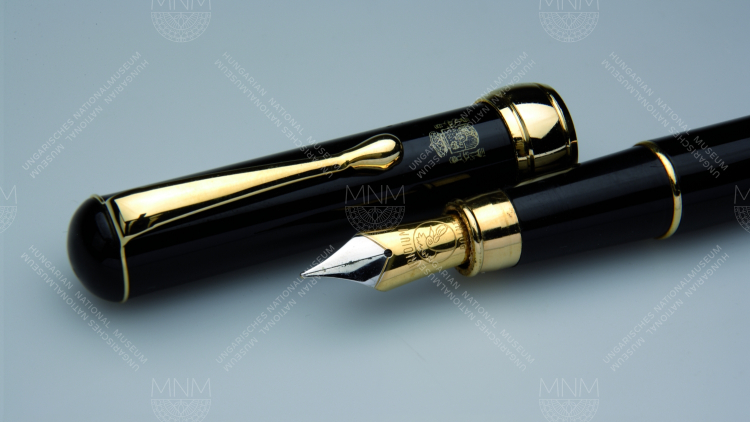
FOUNTAIN PEN ONCE OWNED BY JÓZSEF ANTALL
This pen belonged to József Antall, the prime minister in the first democratic Hungarian government to take office following the changing of the political system in Hungary in 1989–1990. Accommodated in a small wooden box bearing the coat of arms of the Kingdom of Spain and supplied with gold decoration and a gold-and-iridium nib, it was presented to József Antall by Felipe Gonzales, prime minister of Spain, in 1991. The Kingdom of Spain’s coat of arms can also be seen on the cap of the fountain pen.
(History of Hungary, Part Two, Room 20)
BIRD-SHAPED BRONZE VESSELS
Csicser, find-site unknown
10th century BCE
(Between East and West, Room 3)
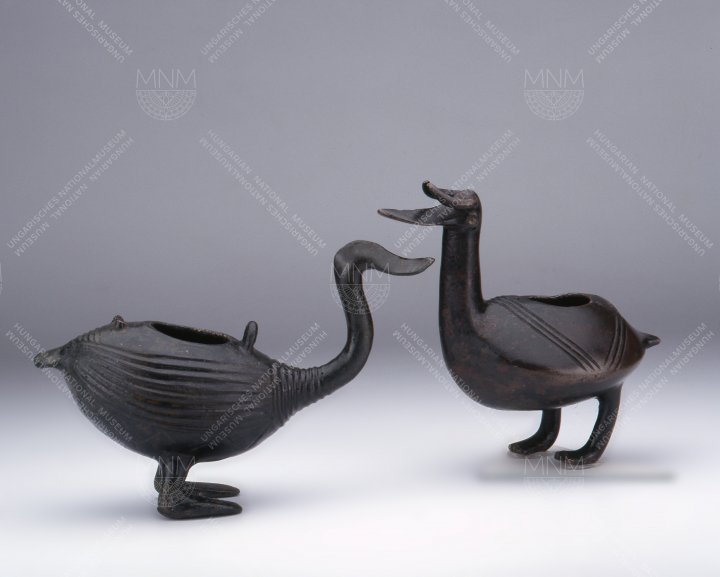
SCYTHIAN GOLDEN STAG, FROM ZÖLDHALOMPUSZTA
At Zöldhalompuszta, near Mezőkeresztes, grave goods consisting of a golden stag, a gold chain ornamented with lion figures, 138 semi-spherical gold forms, and a gold pendant were discovered in 1928. The 38-cm-long stag figure, dropping down on its front legs and with its head turned backwards, is made from sheet gold and has ormanentation in relief. The animals’s head and legs are decorated with a cord pattern. On the area between the antlers and the neck can be seen the head of a bird with a hooked beak. Artefacts similar to the stag figure have come to light among finds from the kurgans of Scythian ruling princes on the steppes of Eurasia. It was made as an ornament for a shield, and it symbolised the social position and power of the shield’s user. The magnificent assemblage may have been committed to the earth during the 6th century BCE
(Between East and West, Room 5)

Seuso Treasure
Probably Kőszárhegy
4th - beginning of the 5th century CE
The Seuso treasure is a treasure trove from the late period of the Roman Empire (4th – 5th centuries). It was named after its owner Seuso, who is identified on the inscription of the so-called hunting or Seuso platter. Its pieces belong to a festive banqueting set and include vessels used for washing and during toilette. Probably in the last decades of the 4th, or at the beginning of the 5th century, the treasure was concealed by its owners, who were most likely fleeing from a war conflict.
In its currently known form, the hoard consists of 14 large silver vessels, as well as a large copper cauldron, in which the items were hidden. Among some thirty precious metal treasure troves including pieces of banqueting sets from the late imperial period, the Seuso treasure is outstanding with regard to both its artistic and material value. Bearing in mind its total weight, the silver set displayed at the exhibition is considered as the most valuable among the existing late imperial silversmith treasures.

ONYX FIBULA
Gold, onion-shaped fibula with an onyx gemstone
Szilágysomlyó,
First half of the 5th century CE
(Between East and West, Room 7)

SILVER FIBULA COVERED WITH SHEET GOLD, WITH GARNETS
Szilágysomlyó,
First half of the 5th century CE
(Between East and West, Room 7)

FOOTED GOBLET MADE OF GOLD
Bócsa, first half of the 7th century CE
Similar to this golden goblet with scalloped decoration, drinking vessels splaying at the rim that were made from sheet silver (unlike this piece from Bócsa) and large, handled jugs that matched them in shape were, it seems, indispensable elements in the sets of drinking vessels used by Avar dignitaries in the 7th century CE. Made locally in the Carpathian Basin and distinct with regard to design, these pieces indicate the developed nature of Avar handicrafts work.
(Between East and West, Room 7)

SABRETACHE PLATE
Silver gilt,
10th century
The palmette motifs in a endless knot on this sabretache plate from Galgóc are reminiscent of motifs on Oriental textiles and frescoes in the Sogdia towns. The Hungarians may have become acquainted with such designs during their time in the East. According to the protocols, horse bones, a neck torque, a pair of earrings, and a silver Arab dirhem were found along with the sabretache plate in the male burial, which was discovered in 1868. The coin, which had been drilled through, was struck by the Samanid amir Nasr II (r. 914–943); it was issued in Samarkand in 918–919. Its last owner may have had it sewn into his clothing or his horse’s harness at the end of the first third of the 10th century.
(Between East and West, Room 10)

METAL TIP FOR A POINTED CAP, FROM BEREGSZÁSZ
Embellishment decorated with palmettes, from Beregszáz
(Beregovo, Ukraine)
(Between East and West, Room 10)
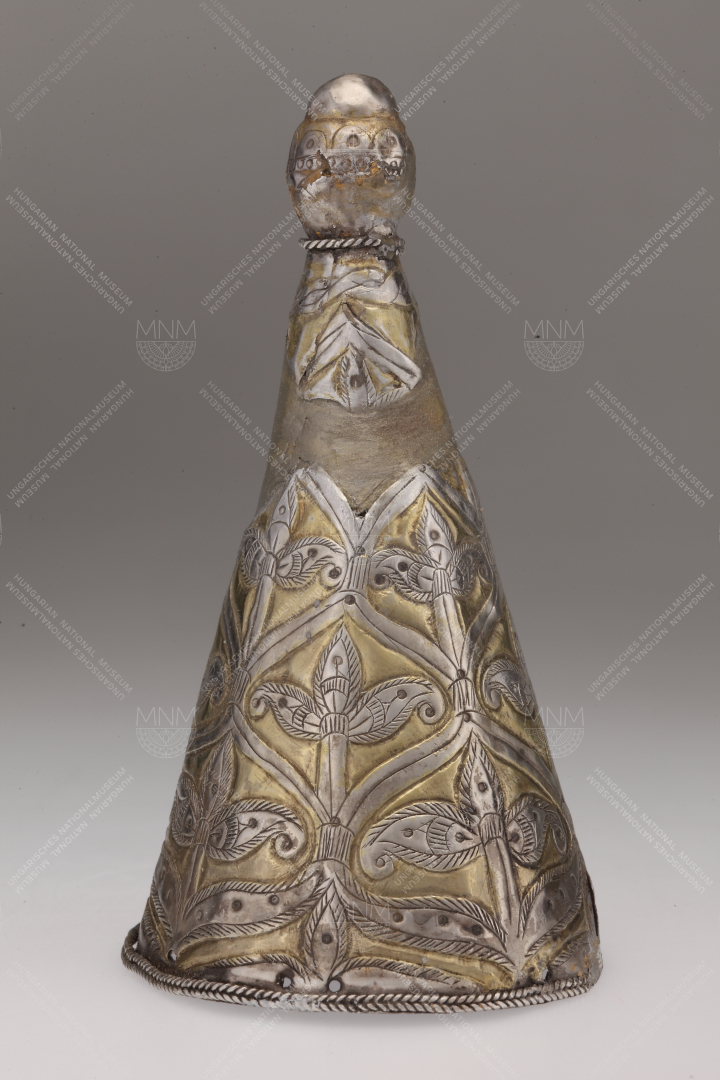
CORONATION MANTLE
This priceless treasure of European textile art was orginally a chasuble. According to the inscription written on it in hexameters, this chasuble was ordered by King Stephen I and Gisela his queen consort in 1031. The masterly gold embroidery which covers almost the entire surface of the piece was made according to a complex pictorial scheme whose basis may have been, according to some researchers, the Te Deum or All Saints litany. Its significance is further heightened by its use, right up until the 20th century, as the mantle worn by kings of Hungary at their coronation.
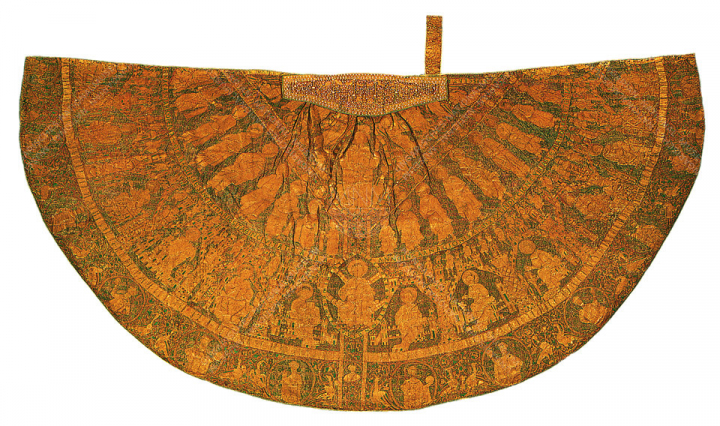
BYZANTINE VESSEL FOR HOLY WATER, FROM BESZTEREC
Second half of the 10th century
This Byzantine silver-gilt holy water vessel inscribed in Greek rests on three – in part reconstructed – lion-griffin feet. On a hexagonal base, the broader lower part of its body is connected to the narrower upper part by a stepped element. On the top, there is a handle, which moves. This is connected to the vessel by means of busts of two youths, and, at the level of the chests of the youths, a damaged inscription in Greek can be seen. The present teading of this is ‘Christ, the living fount of healing’. The vessel is covered by trailer with palmettes on a ground decorated with circles consisting of punched dots. In a lower, oval-shaped space, three palmettes alternate with three mythological beasts. The palmettes are early relics of the so-called flower-and-leaf decoration renewed at the imperial court at Byzantium in the mid-10th century on the basis of Chinese examples.
(History of Hungary, Part One, Room 1)

MONOMACHOS CROWN
Crown of Constantine IX Monomachos, Byzantium, 1042–1050
The assemblage consists of seven gold plates each of which has a semi-circular top and cloisonné enamel decoration. It was recovered at Nyitraivánka (Ivanka pri Nitre, Slovakia) in 1861. The plates depict, respectively, Constantine IX Monomachos, emperor of the ‘Romans’, (r. 1042–1055), and six standing female figures; there are also two medallions featuring busts of the apostles and brothers St. Peter and St. Andrew respectively. The assemblage contains three pairs of gold plates, each of a different height. Two of the gold plates show the last members of the Macedonian dynasty: Zoe (d. 1050) and her sister Theodora (d. 1056) respectively. Two others each depict a dancer, and another two Justice and Humility respectively. The figures are flanked by decoration consisting of trailer and birds and (in the case of the Virtues) pairs of cypresses. The plates may originally have been attached to a cap and may be interpreted as a universal peace programme in a Sassanid, Islamic, antique, and Old Testament context alike. For their part, the two apostles, included in the assemblage in a secondary role, refer to Rome and Constantinople, locations associated with their respective activity, as well as to the Latin and Greek churches they respectively led.
(History of Hungary, Part One, Room 1)

MANTLE CLASP
This silver-gilt clasp, recovered at Bajna, was made in the mid-13th century using the opus duplex technique especially favoured at the courts of Andrew II and Béla IV.
(History of Hungary, Part One, Room 1)

CROWN FROM MARGARET ISLAND
Silver-gilt crown with gemstones
Margaret Island, Budapest, 13th century
Decorated with lilies and rosettes, this crown was recovered in 1838 from one of the royal burials (perhaps that of King Stephen V of Hungary) at the Dominican nunnery on Margaret Island. Influenced by the classic French Gothic style, it may been made in the second half of the 13th century.
(History of Hungary, Part One, Room 1)
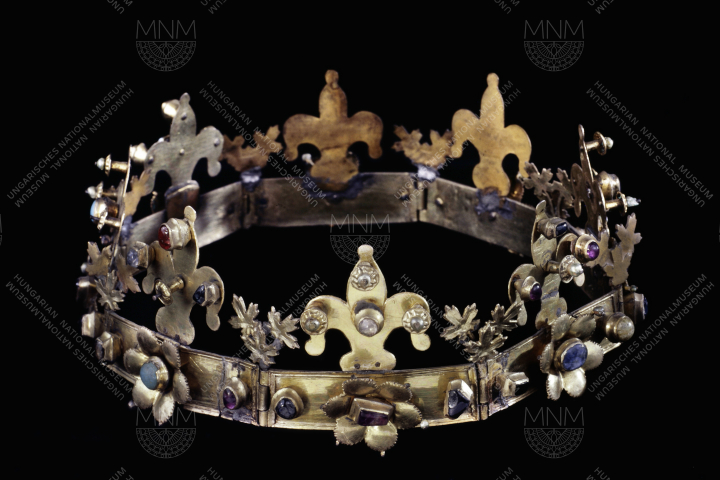
AQUAMANILE
cca. 1200
The centaur and the boy figure playing a flute and standing on its back (perhaps Chiron and Achilles) is a product from the 1220s made by an outstanding bronze-casting workshop in Hildesheim. It may have reached Hungary on account of the close links between the court of Hungary’s King Andrew II and the Holy Roman Empire.
(History of Hungary, Part One, Room 1)

TRENCSEN HELM
Late 14th century/early 15th century
(History of Hungary, Part One, Room 2)
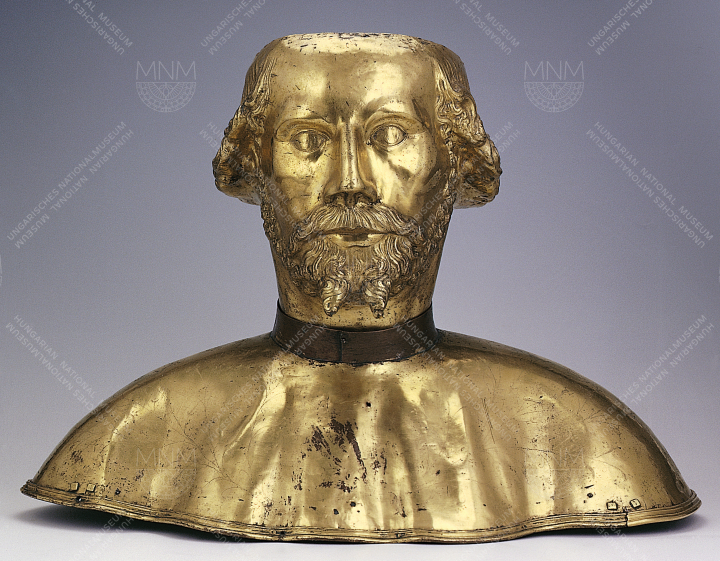
CEREMONIAL SADDLE
Ceremonial saddle from the time of Sigismund of Luxemburg, cca. 1408–1425
Many bone carvings on this ceremonial saddle, which was purchased by Miklós Jankovich in Bucharest, feature themes connected with St. George and the Dragon. These themes were favoured at court. However, we also see the emblem of the Order of the Dragon, which was founded by King Sigismund. This underpins the legend that the saddle originally belonged to Vlad III (Vlad the Impaler), prince of Wallachia, a ruler also known as Vlad III Dracula, on account of his membership of the order.
(History of Hungary, Part One, Room 3)
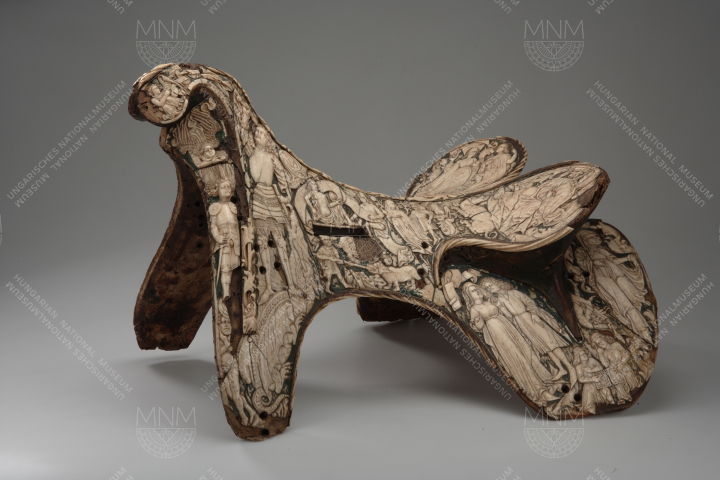
LITURGICAL CRUETS FROM NAGYVÁRAD
First quarter of the 16th century
From Nagyvárad, this pair of jugs for liturgical use from the early 1500s combines Late Gothic naturalism with filigree decoration. Purchased from the Bethlen family and made in the first quarter of the 16th century, the jugs, which are from Nagyvárad Cathedral according to Bethlen family tradition, feature the Nuremberg Late Gothic pear shape along with more abstract granulated filigree surface decoration, which is considered a Hungarian speciality. One of the earliest known drawings of a pear-shaped product of goldsmiths’ art is by Albrecht Dürer, whose father was from Ajtós, near Nagyvárad. In this way, the artefact attests to Hungarian links with Nuremberg in the field of goldsmith’s work in the time of Dürer also.
(History of Hungary, Part One, Room 4)

GOBLET
Goblet with the armorial bearings of the Ernuszt, the Pálóczi and the Rozgonyi families. Decorated with burring and beading and fashioned in the late 15th century, this goblet may have been commissioned by János Ernuszt, chief equerry to King Vladislaus I of Hungary; on it are Ernuszt’s armorial bearings, and also those of his father-in-law and mother-in-law.
(History of Hungary, Part One, Room 4)

GLASS STOOP ONCE BELONGING TO KING MATTHIAS CORVINUS
Glass stoop once owned by King Matthias Corvinus of Hungary, Venice,
second half of the 15th century; foot: late 16th century/early 17th century
(History of Hungary, Part One, Room 5)

PAINTED WOODEN SHIELD
Painted wooden shield, with a letter M, referring to King Matthias Corvinus, second half of the 15th century
(History of Hungary, Part One, Room 5)
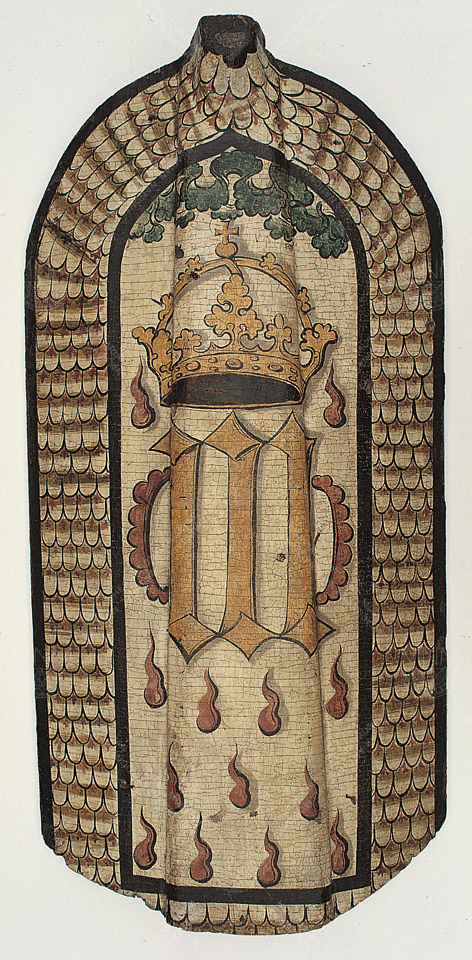
THRONE TAPESTRY
Most 15th-century textiles that have come down to us are pieces which were ecclestiastical commissions and which were in ecclesiatical use first and foremost. However, this tapestry, commissioned by King Matthias Corvinus and considered a masterpiece of Italian textile art, was made specifically for secular use. Set in a wreath of fruit, the armorial bearings indicate the person who ordered the tapestry, while the detailed artistic design and the costly materials employed serve display purposes.
(History of Hungary, Part One, Room 5)
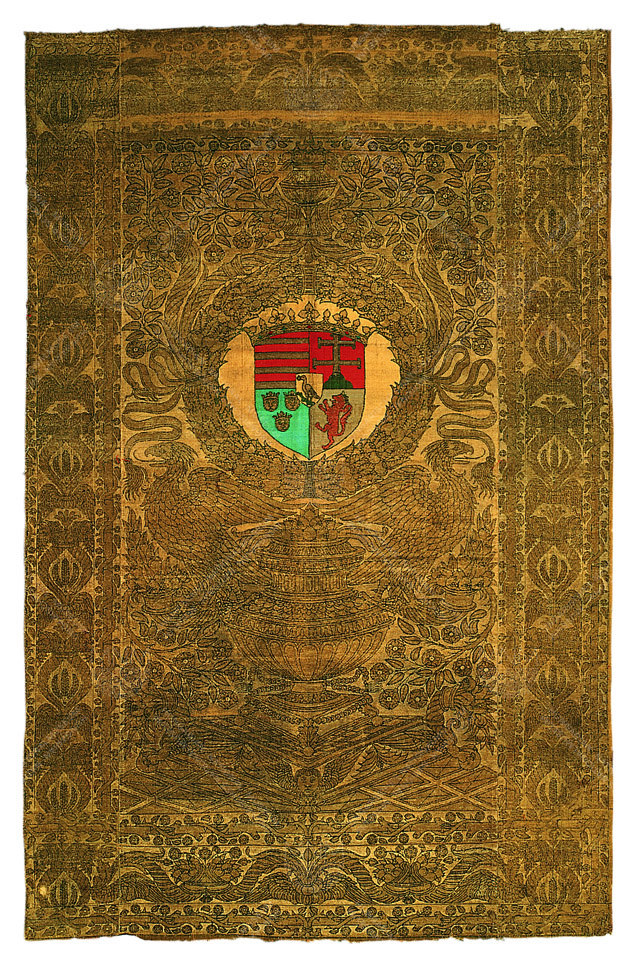
ATTIRE ASSOCIATED WITH MARY OF AUSTRIA, QUEEN CONSORT OF HUNGARY
The earliest women’s attire held by the Museum’s Textile Collection, this clothing may have belonged to the wardrobe of the spouse of King Louis II of Hungary. The ground fabric is green Italian damask; there are cone-shaped cuffs with metal thread and strips which embellish the upper part. The attire consists of two garments: a long chemise and the green outer garment following the Burgundian fashion.
(History of Hungary, Part One, Room 5)
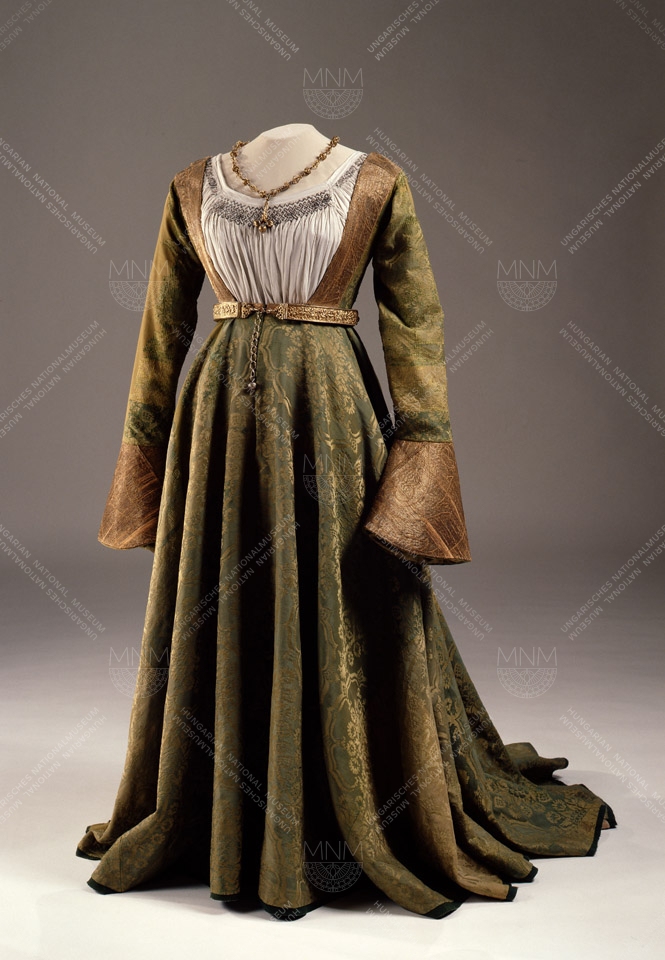
PENDANT
Pendant decorated with an opal, first half of the 16th century
Set with an opal and made with sophisticated artistic taste, the artefact testifies to the high technical standard of jewellery art at this time. Tradition has it that this pendant belonged to Isabella, queen consort of King John I (Szapolyai) and later queen dowager.
(History of Hungary, Part One, Room 6)

SET OF CHOIR STALLS FROM NYÍRBÁTOR
The Renaissance magnificence of the court of King Matthias Corvinus of Hungary and Beatrix his consort was accompanied by the rapid spread of the Renaissance style in the country. An outstanding example of it is this set of choir stalls commissioned by the Báthoris: the ledges, friezes, supports, back panels, arm supports, seat surrounds,, side panels, dividing panels between the individual seats, and arched recesses are all made in the Renaissance style, with carving and inlay work. One panel shows the names and ranks of those placing the order (György, István, and András Báthori), as well as the year of production (1511); on another panel we can see the mark of the master who made the stalls: F. Marone. Some of the inlaid back panels depict cupboards with half-open doors, revealing books and vessels on the shelves inside.
(History of Hungary, Part One, Room 6)
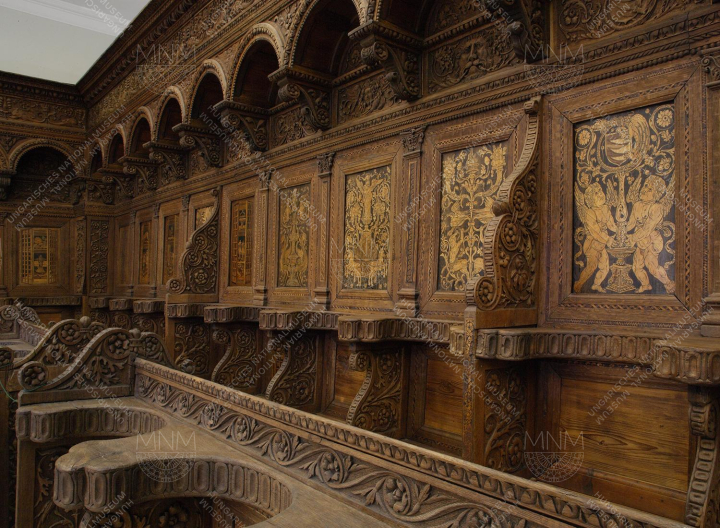
PÁLFFY STOOP
Gala stoop that one belonged to Count Miklós Pálffy, 1598
(History of Hungary, Part One, Room 6)

BRÓZER CHALICE
Golden chalice
Donated to the Reformed Church in Kolozsvár by György I Rákóczi
István Brózer,
Kolozsvár, 1640
(History of Hungary, Part One, Room 7)
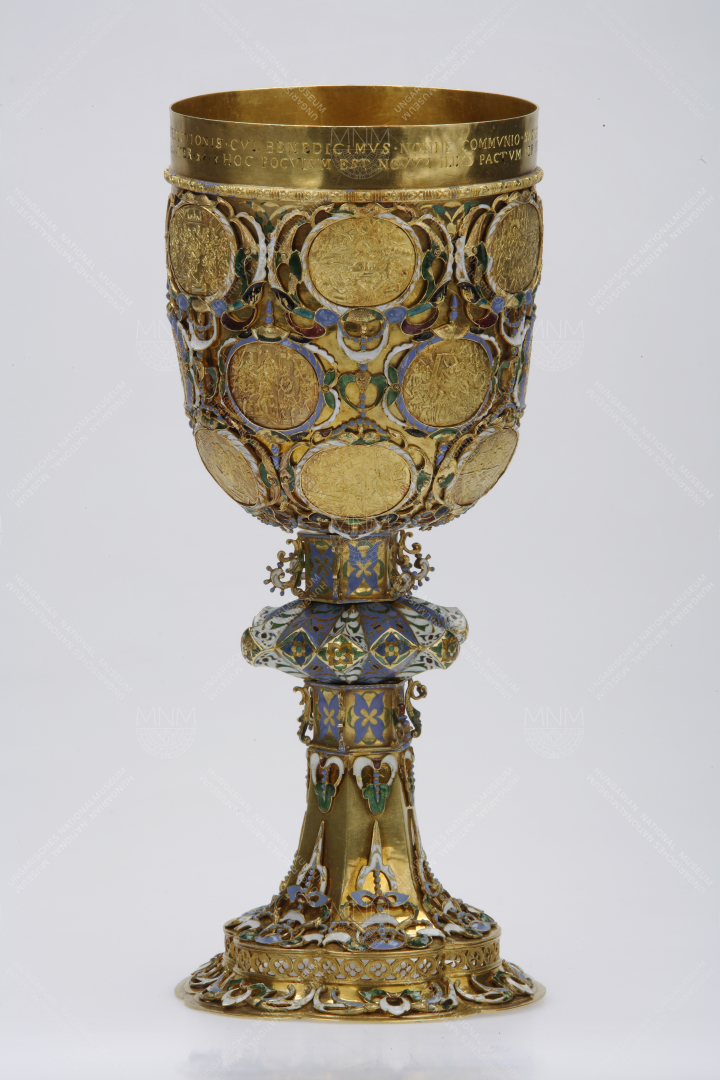
DIAMOND PENDANT
cca. 1620–1640
(History of Hungary, Part One, Room 7)

GALA ATTIRE ONCE BELONGING TO CATHERINE OF BRANDENBURG
Tradition has it that this plum-coloured silk attire was worn by Catherine of Brandenburg, the second wife of Gabriel Bethen, prince of Transylvania. The clothing, which consists of a skirt and a bodice, is richly embroidered with metal thread. The tulips, carnations, and daisies seen below the arching are elements frequently found on surviving 17th-century embroidery in the Hungarian territories.
(History of Hungary, Part One, Room 7)
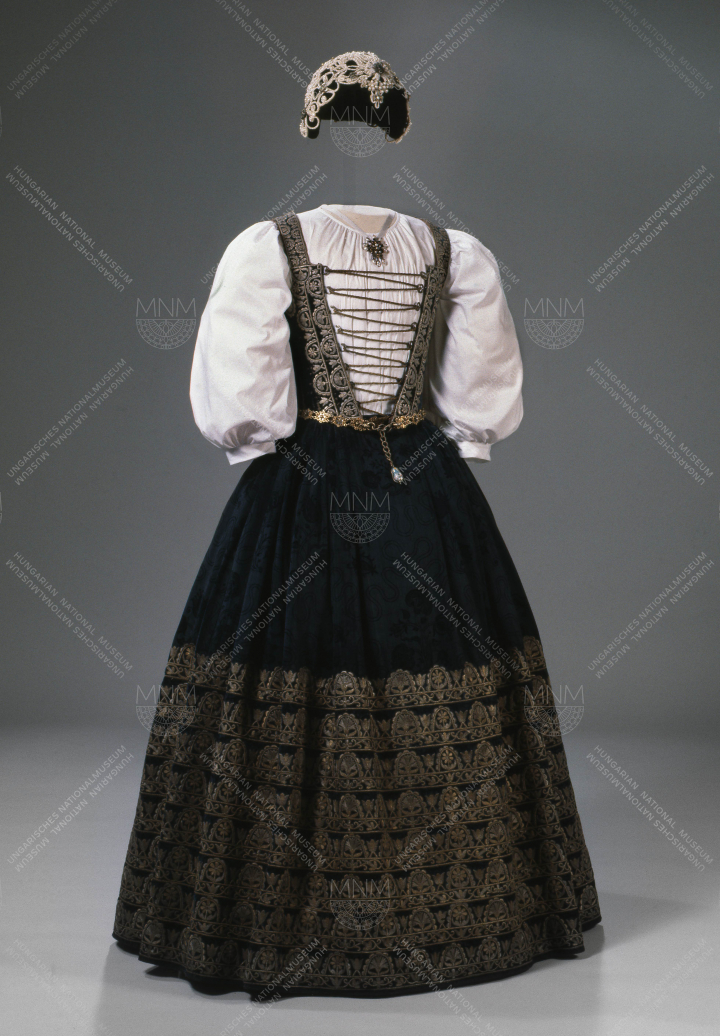
EMBLEM OF THE ORDER OF ST. STEPHEN
Gemstone-decorated emblem of the Royal Hungarian Order of St. Stephen worn by Maria Theresa, 1764
(History of Hungary, Part Two, Room 10)
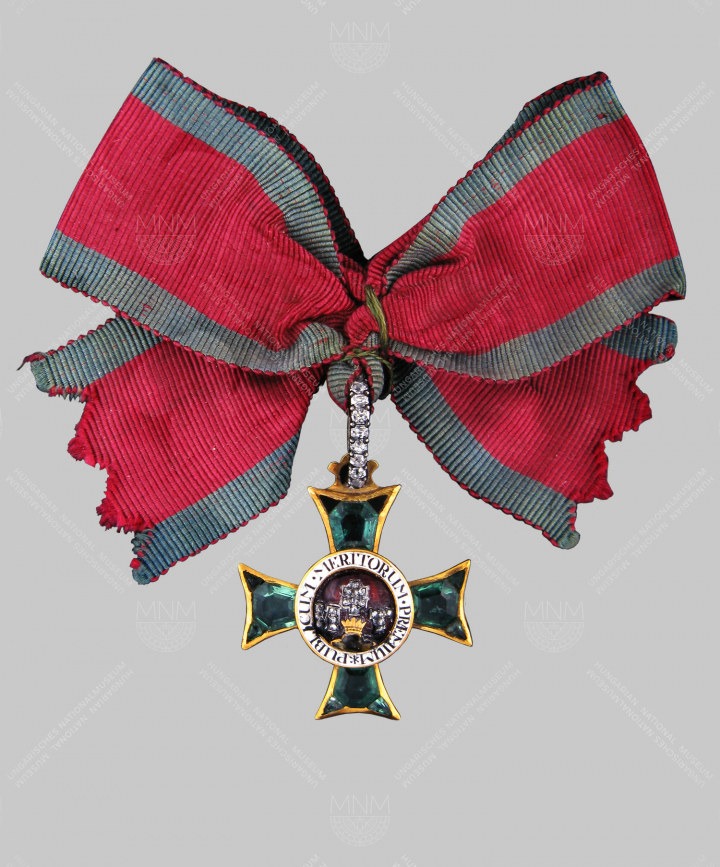
GALA ATTIRE FOR A MALE CHILD
According to tradition, this Hungarian-tailored set of clothes consisting of a mente (a long Hungarian coat), a dolman, trousers, and cap was made for Joseph, the eldest son of Maria Theresa. It is cut from floral-patterned silk repp. We know of many pictures showing the monarch and her children in Hungarian attire.
(History of Hungary, Part Two, Room 10)

MOZART’S TRAVELLING CLAVICORD
This small, simple, travelling instrument made by Johann Andreas Stein in 1762 is more than merely the sole surviving clavicord made by the famous Augsburg organ builder (the inventor of the so-called Vienna action. It is also a travelling and practice instrument that was used by Wolfgang Amadeus Mozart. The instrument and the documentation connected with it were purchased by the Museum in 1965.
(History of Hungary, Part Two, Room 13)
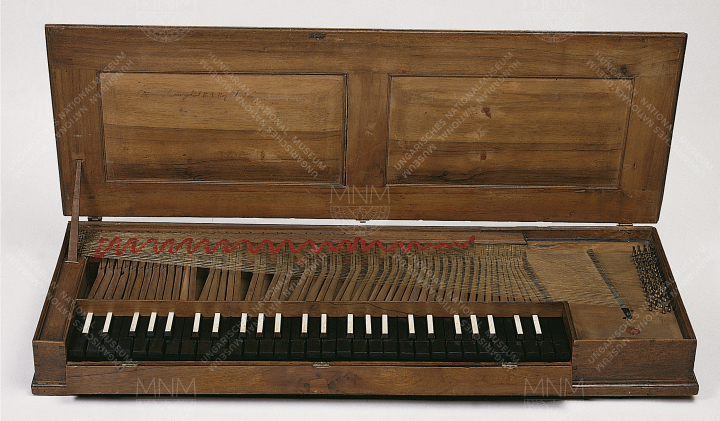
COUNT ISTVÁN SZÉCHENYI
Painting by Miklós Barabás, 1848
At the Hungarian Diet of 1825, Count István Széchenyi, the initiator of the Reform Age in Hungary, offered a year’s income from his estates for the foundation and endowment of a Hungarian Academy of Sciences, ‘to strengthen and develop nationhood and the language’. His many impressive achievements aimed at the creation of a modern Hungary. Széchenyi was a fine-looking man who spoke foreign languages; who read works of classical and modern literature in the original; who was a great sportsman who excelled at swimming, riding, and rowing; and who was, in addition, a member of aristocratic society. Initially, he considered the Austrian Empire as a whole to be his homeland, but later, in the 1820s, decided that he wished to live his life as a public person fighting for the benefit of the Hungarian nation and for the advancement of Hungary. He founded a club to promote discussion of political, economic, and social issues. In his works (Credit, World/Light, Stádium), he outlined the first comprehensive programme in Hungary for advancement from feudal poverty through the establishment of modern societal relations. Crowning his many reforming initiatives was the construction of the Chain Bridge, an all-the-year-round bridge linking the cities of Pest and Buda. By pushing through the building of this bridge, he aimed to stimulate economic activity and transportation, thus facilitaing the development of a major city, a true capital from Hungary, from these two small medieval towns on either side of the Danube; and, by doing so, to create a rival for Vienna and to attract the Habsburg Empire’s epicentre to the banks of the Danube in Hungary.
(History of Hungary, Part Two, Room 11)
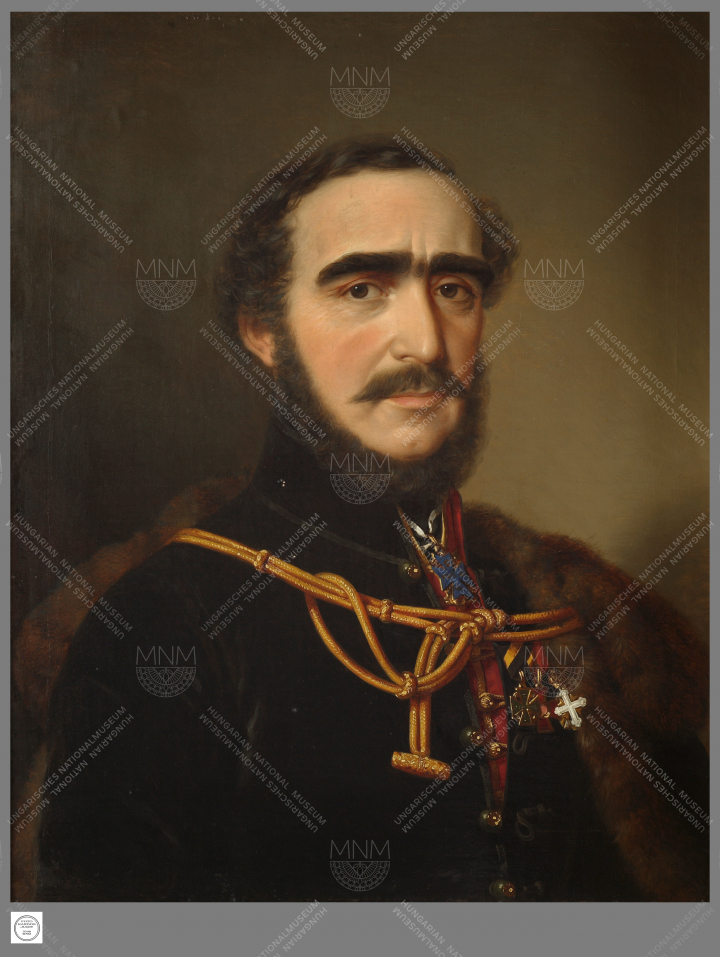
COCKADE ONCE BELONGING TO SÁNDOR PETŐFI
Sándor Petőfi is one of the most significant and influential figures in Hungarian literature. As one of the leaders of the Youths of March who sparked the 15 March 1848 Revolution and later on as a martyr of the 1848–49 War of Independence, Petőfi has become a central figure in the legendry of the nation. His life has become the subject of a cult at least as much as his poetry has. Featuring the national colours, the cockade seen here was, according to the document of attestation, in Sándor Petőfi’s possession.
(History of Hungary, Part Two, Room 12)
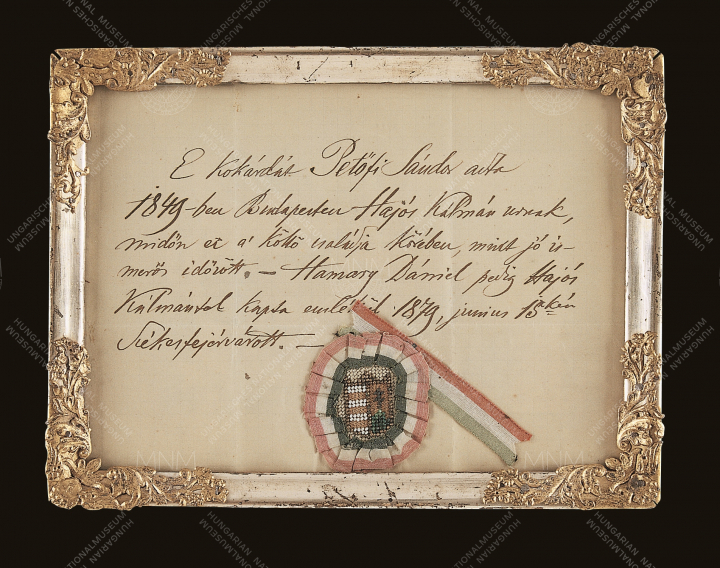
ARTÚR GÖRGEI’S SWORD
Arthur Görgei's „1845 M” cavalry officer’s sword with an embedded magnifying glass with which the notoriously short-sighted general could read maps.
(History of Hungary, Part Two, Room 12)

WAISTCOAT ONCE BELONGING TO COUNT LAJOS BATTHYÁNY
Pierced through by bullets, this white piqué waistcoat was worn by Count Lajos Batthyány at the time of his execution. Following the defeat of the 1848–49 Hungarian War of Independence, Batthyány, prime minister in the first responsible Hungarian government, was put to death on orders from Haynau, the Austrian military commander invested with full powers in Hungary. The execution took place on 6 October 1849 in the courtyard of the so-called New Building in Pest. On her last visit to him in his condemned cell, Batthyány’s loyal wife, Countess Antónia Zichy, smuggled in a small dagger. On the night before he was due to be executed, he attempted, unsuccessfully, to commit suicide with it, to avoid the shame of hanging. Because of the life-threatening wound on his neck, Batthyány was executed by firing squad. The waistcoat he was wearing at the time was presented to the Hungarian National Museum by his widow.
(History of Hungary, Part Two, Room 14)

GOVERNOR-PRESIDENT’S GALA ATTIRE ONCE BELONGING TO LAJOS KOSSUTH
Consisting of a braided broadcloth atilla (Hungarian short outer coat) and red slim-fit trousers, this attire was at one time worn by Lajos Kossuth. The garments came to the Hungarian National Museum from the widow of Ferenc Kossuth, son of Lajos Kossuth.
(History of Hungary, Part Two, Room 12)

BEETHOVEN–LISZT GRAND PIANO
Grand piano once owned by Ludwig van Beethoven and later on by Ferenc (Franz) Liszt.
In 1873, after jubilee celebrations to mark the fiftieth anniversary of the start of his career, Ferenc Liszt decided, as a Hungarian patriot, to present his most precious artefacts to the Hungarian National Museum. From every point of view, the best-known work of art belonging to Liszt was a musical instrument which he acquired in 1846 and which, from that time onwards, he, too, treated as a treasure from the past. This was a grand piano made by Thomas Broadwood that was sent to Beethoven in Vienna in 1817.
(History of Hungary, Part Two, Room 13)
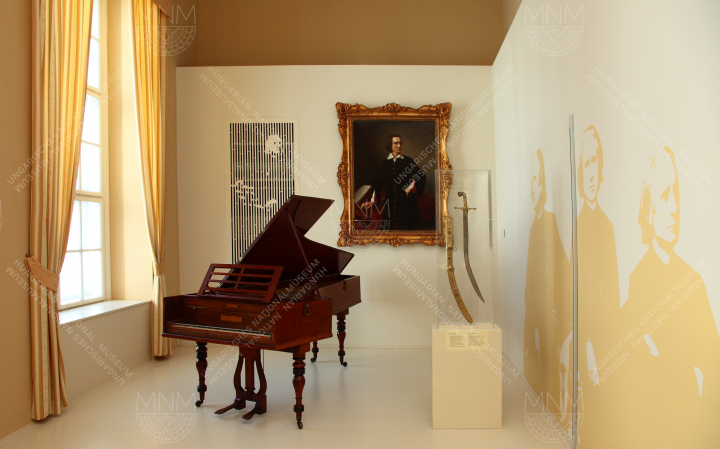
FURNISHINGS OF A ROOM USED BY FERENC DEÁK
On show here are furnishings from Ferenc Deák’s room at the Queen of England Hotel in Pest, along with some of the politician’s personal effects. Deák was one of the architects of the Compromise of 1867, an agreement between Austria and Hungary which created the Dual Monarchy (Austria–Hungary). This understanding came about on the basis of proposals formulated in Deák’s ‘Easter Article’ published without attribution in the 16 April 1865 number of the newspaper Pesti Napló. On 20 February 1867, Francis Joseph appointed Count Gyula Andrássy as first prime minister of the the Hungarian half of the Dual Monarchy, which lasted until late 1918. On 8 June 1867, Francis Joseph was crowned king of Hungary.
(History of Hungary, Part Two, Room 14)
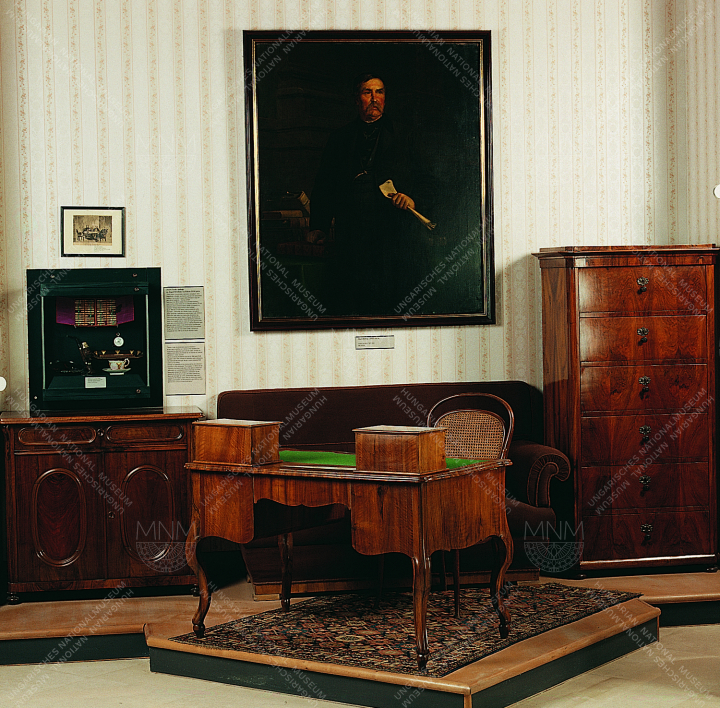
LADY’S GALA ATTIRE
Following Hungarian traditions, this blue silk gala attire was made in 1867 for the coronation of Francis Joseph I. The long train of the skirt, which accorded with court prescriptions, is covered with rich metal-thread embroidery depicting ears of wheat and vine leaves. The apron for the skirt and the veil attached to the bonnet are also embroidered in metal thread. After minor alterations, this attire was worn by Gabriella Szécsenyi at the coronation of King Charles IV of Hungary in 1916.
(History of Hungary, Part Two, Room 14)
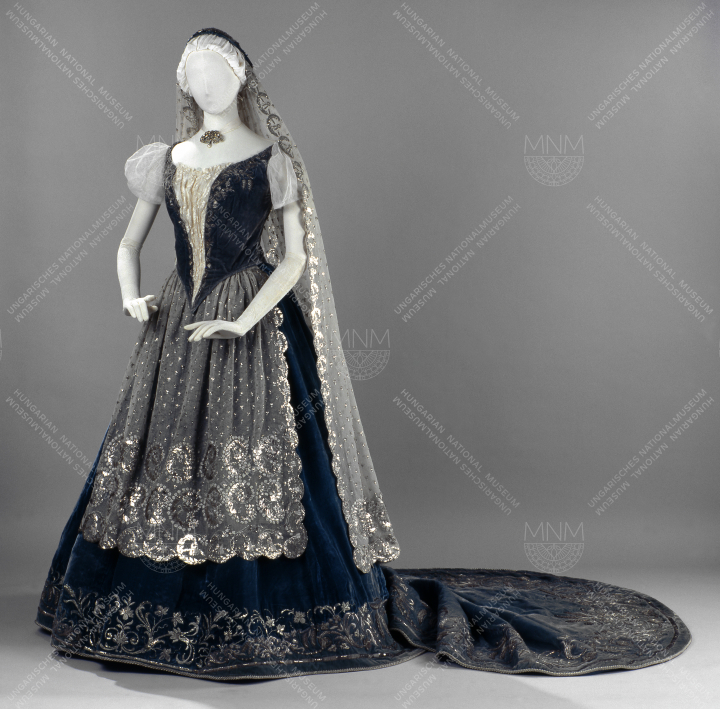
MEERSCHAUM PIPE MADE AT THE TIME OF HUNGARY’S MILLENNIUM
Adler workshop, 1896
This large pipe, made in the renowned workshop of Fülöp Adler and Son, sums up the way Hungary’s history was seen at the time of Hungary’s Millennial Celebrations in 1896, one thousand years after the arrival of the Hungarians in the Carpathian Basin. Carved from meerschaum, the bowl of the pipe consists of the allegorical female figure Hungaria; she holds the coat of arms of Hungary with its double cross and Árpád stripes. On the long neck part can be seen, on horseback, the conquering tribal chiefs and the proud figure of Árpád, the ruling prince. On either side of the shank we see the Hungarian people arriving in their new homeland (a farmer leading oxen, people on horseback); these scenes were inspired by the Feszty cyclorama. On the foot part is a half-length portrait of of St. Stephen, the founder of the Hungarian state. On the front side, in pride of place, there is a portrait of King Francis Joseph of Hungary and his consort Queen Elizabeth. Above their heads, two cherubs hold the Holy Crown of Hungary. Like this pipe, the rhetoric of the millennial celebrations extolled Francis Joseph as a second Árpád who, with ‘St. Stephen’s Crown’ upon his head, was launching the Hungarians into the second thousand-year period in their history.
(History of Hungary, Part Two, Room 14)
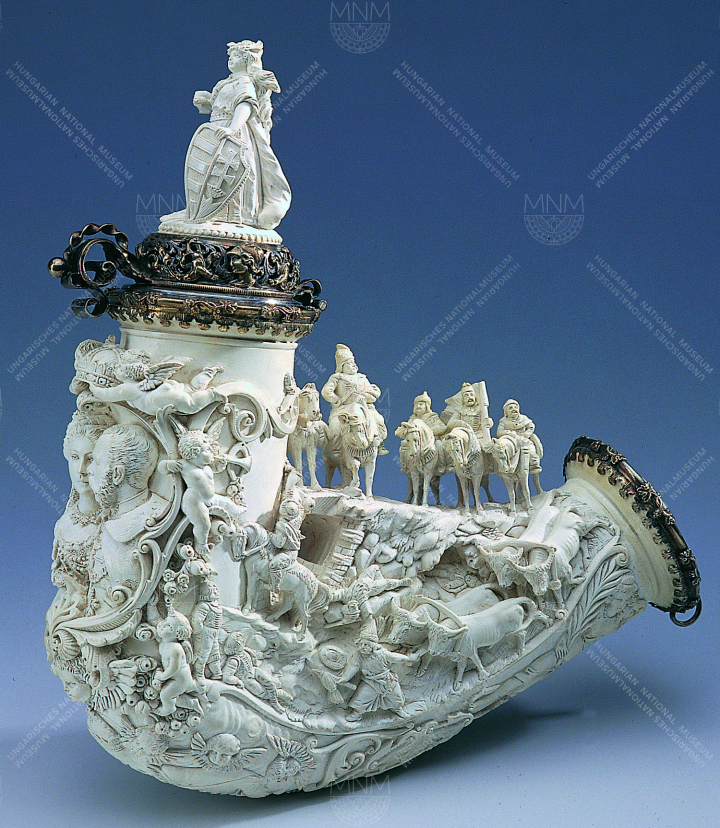
BODICE ONCE BELONGING TO QUEEN ELIZABETH (SISI)
On 10 September 1898, Francis Joseph’s consort Queen Elizabeth, so dear to Hungarians, was about to take a boat trip on Lake Geneva when she was atttacked by an Italian anarchist named Luigi Lucheni. After a minor fright, she boarded the vessel with her Hungarian lady-in-waiting Countess Irma Sztáray. She then soon became unwell, on account of of a stab wound near to her heart, and could not be saved. The black silk bodice she was wearing on the day of the attack was presented to the Queen Elizabeth Memorial Museum founded in 1907; from there it passed to the Hungarian National Museum.
(History of Hungary, Part Two, Room 15)

CHEST PRESENTED TO KING CHARLES IV OF HUNGARY ON HIS CORONATION
Francis Joseph, the monarch of Austria–Hungary, died towards the end of 1916, in the middle of the First World War. His successor, who reigned as Charles IV of Hungary, was crowned king of Hungary in the Matthias Church in Buda’s Castle District on 30 December 1916, amid ceremonial reminiscent of the earlier ‘happy times of peace’. In this silver chest, the country gave its present to the new monarch, along with its good wishes.
(History of Hungary, Part Two, Room 16)

ADVERTISEMENT POSTER
Géza Faragó
Advertisement for incandescent lightbulbs that were made by the Tungsram Factory
cca. 1912
(History of Hungary, Part Two, Room 16)
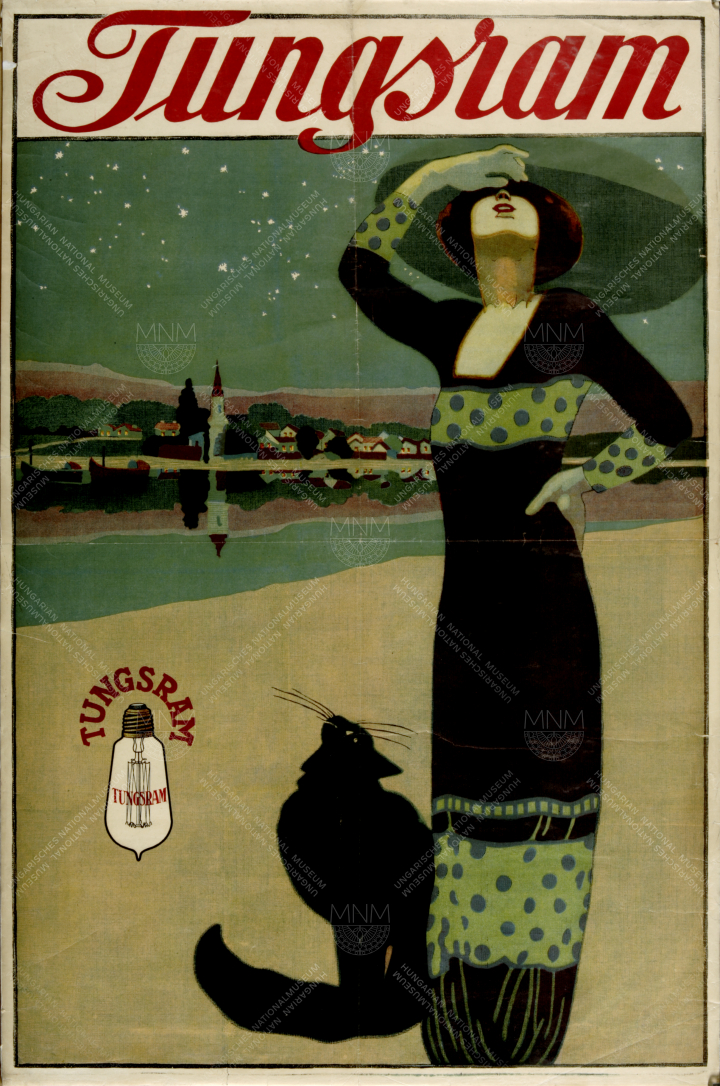
FIRST WORLD WAR POSTER
Poster by Mihály Bíró against the the horrors of war; the artist made it during the Balkan Wars, cca.1912
(History of Hungary, Part Two, Room 16)

RED LOCOMOTIVE
Sándor Bortnyik: Red Locomotive,
1918 (oil, canvas)
A dynamic, Expressionist-Cubist symbol of the approaching revolutions
(History of Hungary, Part Two, Room 16)

DRESS UNIFORM ONCE BELONGING TO MIKLÓS HORTHY
Admiral’s dress uniform worn by Regent Miklós Horthy
(History of Hungary, Part Two, Room 17)
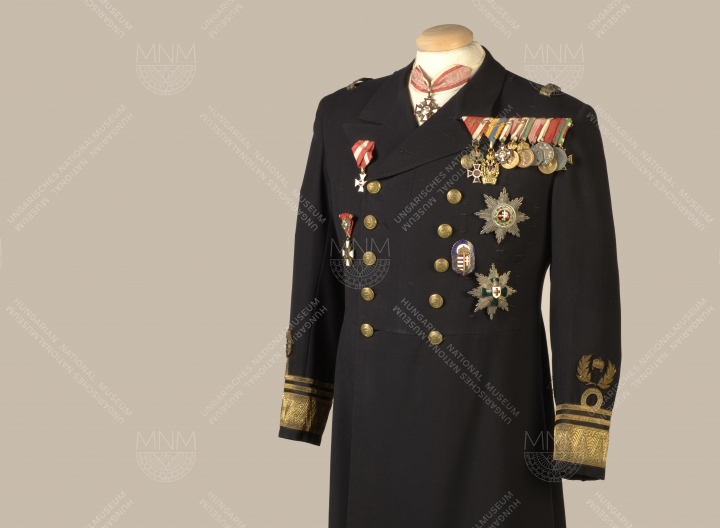
ART DECO ROOM
Counterpoint to the Neo-Baroque world: corner for reading in a modern apartment in the capital city
(History of Hungary, Part Two, Room 17)
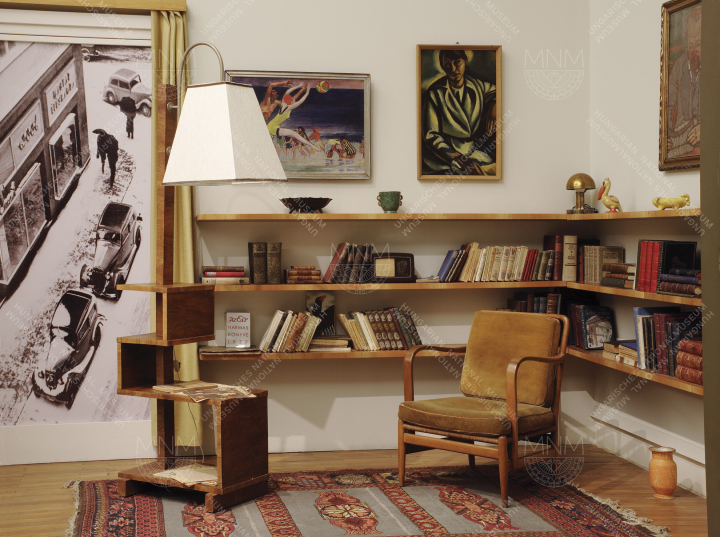
HAND TAKEN FROM A STATUE OF STALIN
Pulled down on the evening of 23 October during the Hungarian Revolution of 1956, the Stalin statue in Budapest’s City Park was one of the main symbols of the system overthrown at that time. After being toppled, the statue was broken up by the angry crowd. Our exhibition displays the ‘almighty’ hand. (The statue was made by Sándor Mikus.)
(History of Hungary, Part Two, Room 20)

LIGHTER ONCE BELONGING TO IMRE NAGY
Table lighter with the initials of the martyr Imre Nagy, prime minister of Hungary during the Revolution of 1956,
1950s
(History of Hungary, Part Two, Room 20)

FOUNTAIN PEN ONCE OWNED BY JÓZSEF ANTALL
This pen belonged to József Antall, the prime minister in the first democratic Hungarian government to take office following the changing of the political system in Hungary in 1989–1990. Accommodated in a small wooden box bearing the coat of arms of the Kingdom of Spain and supplied with gold decoration and a gold-and-iridium nib, it was presented to József Antall by Felipe Gonzales, prime minister of Spain, in 1991. The Kingdom of Spain’s coat of arms can also be seen on the cap of the fountain pen.
(History of Hungary, Part Two, Room 20)









